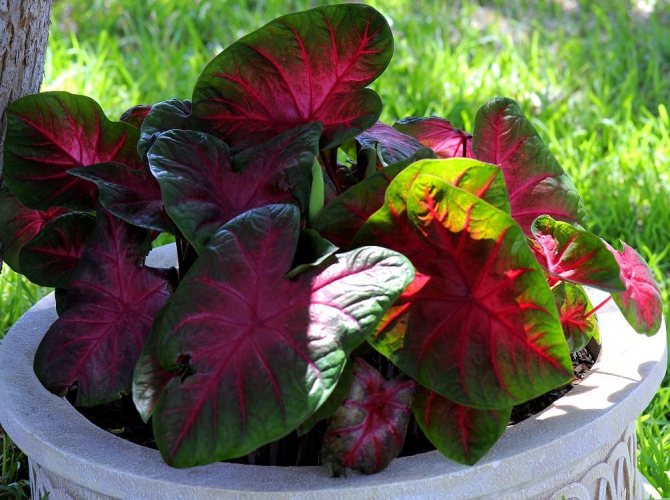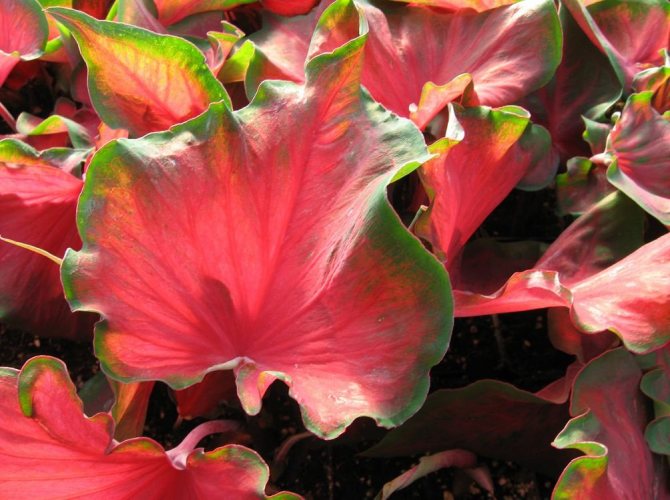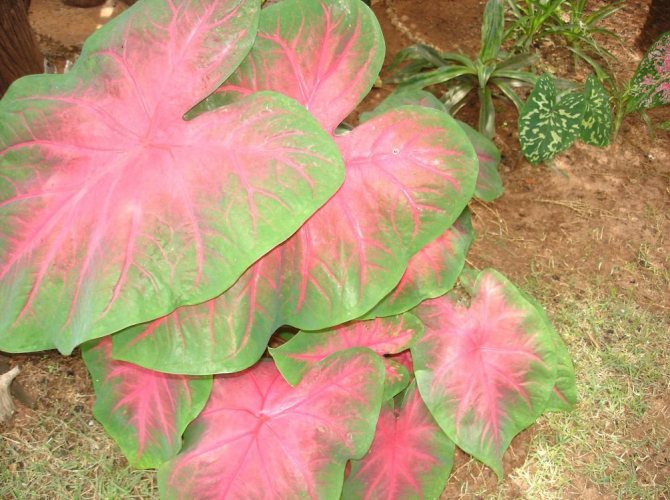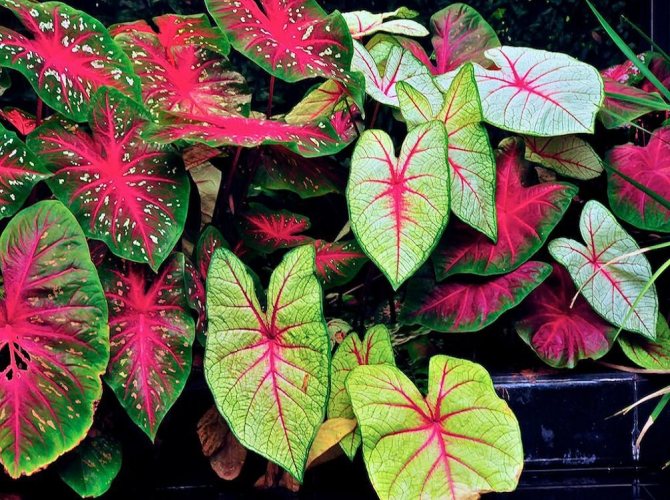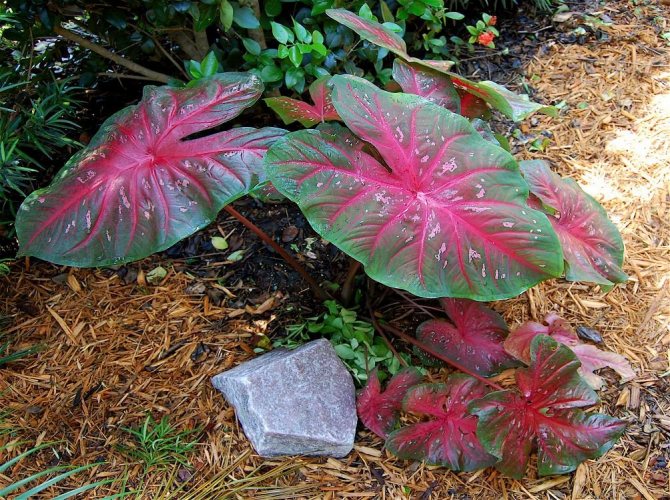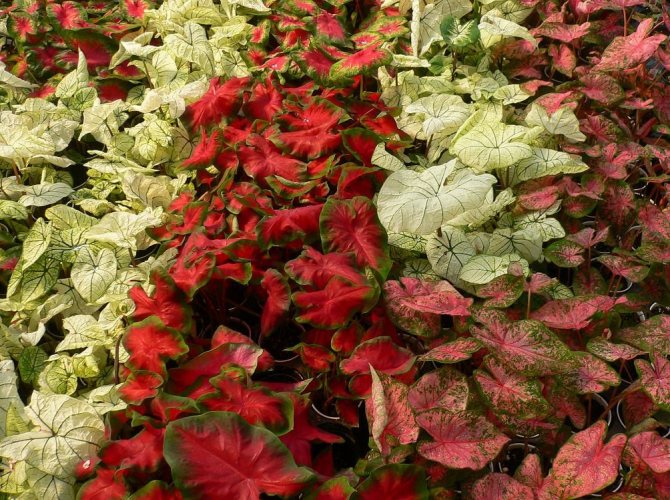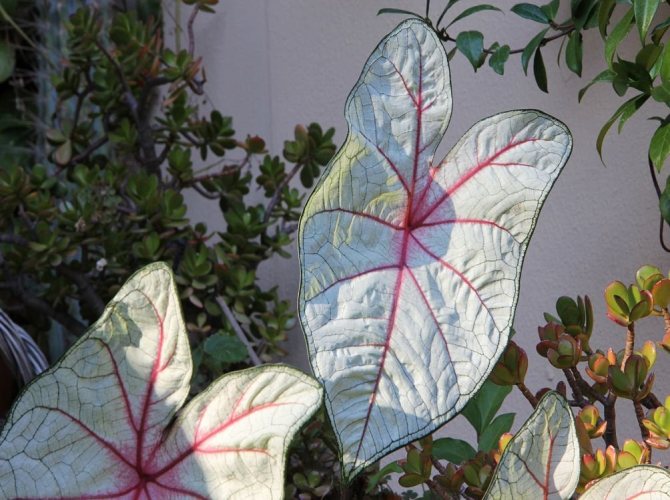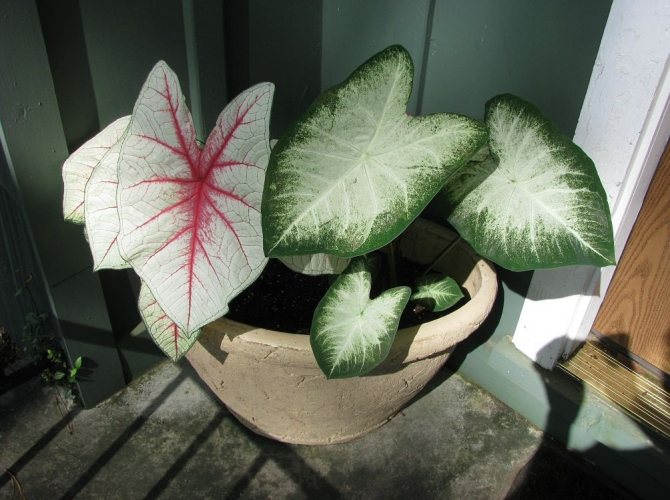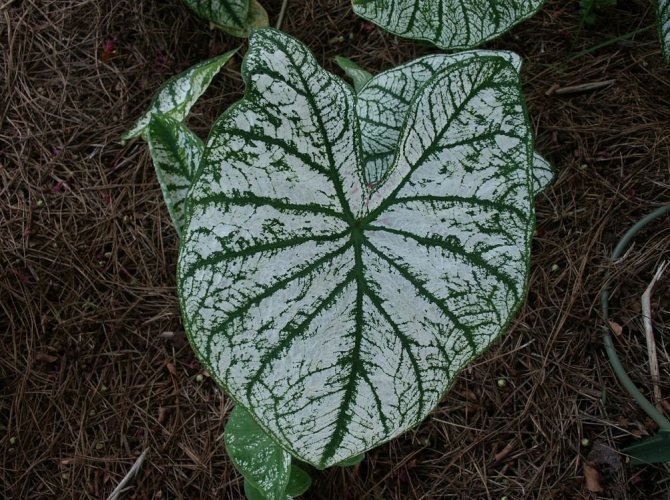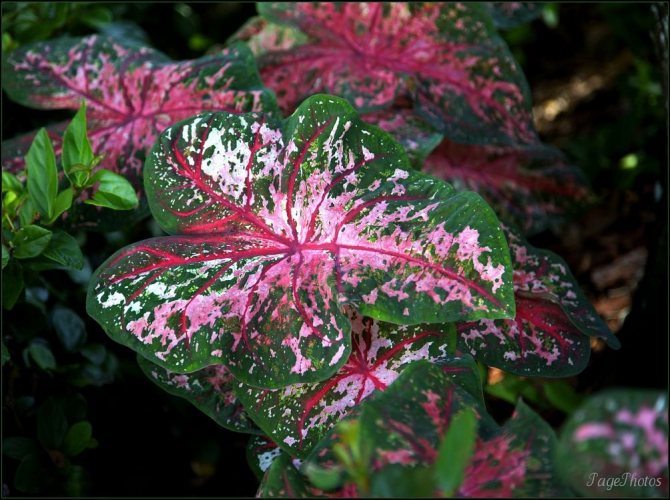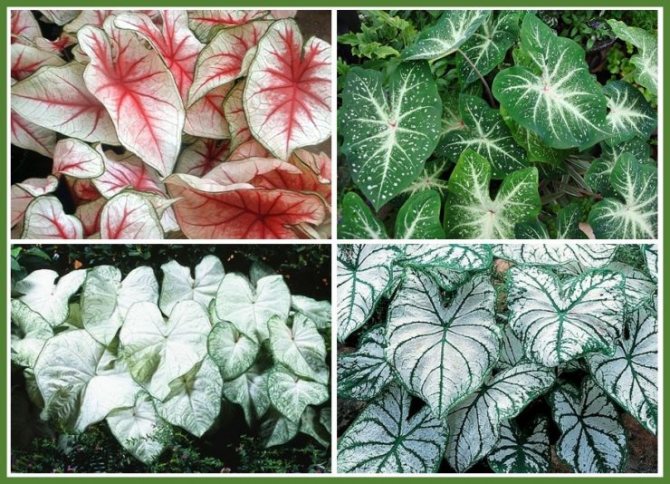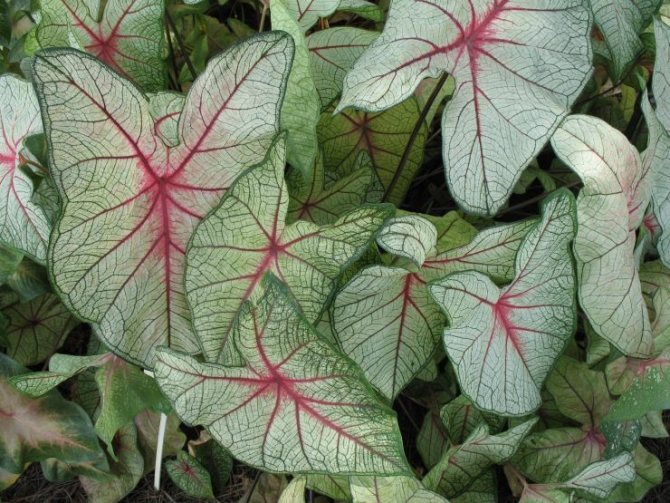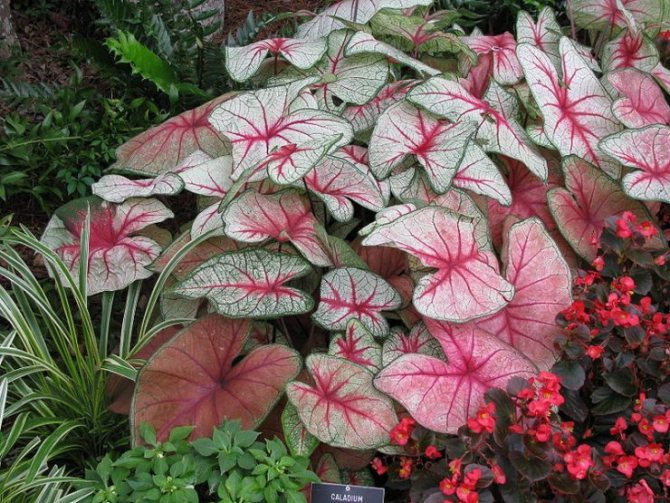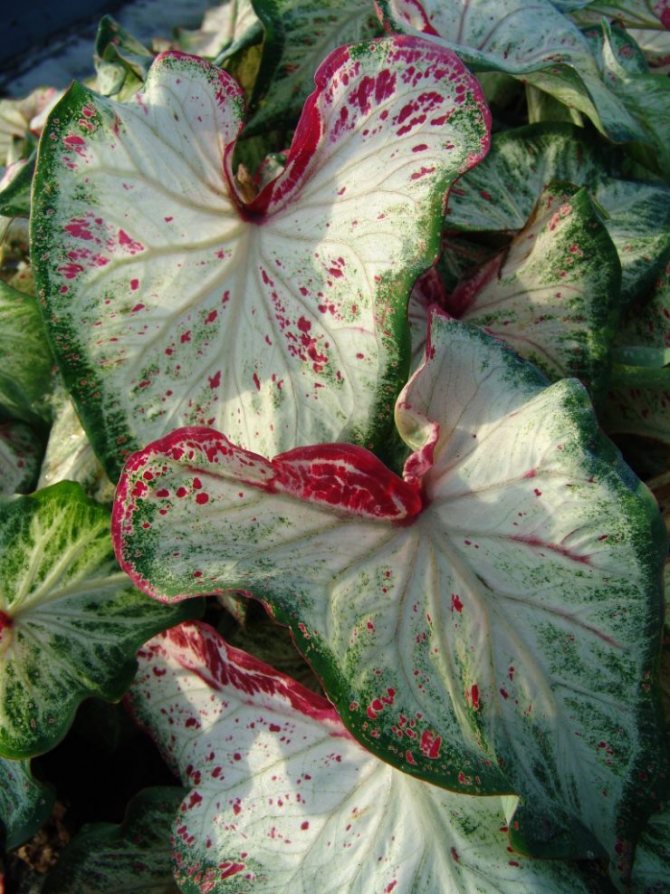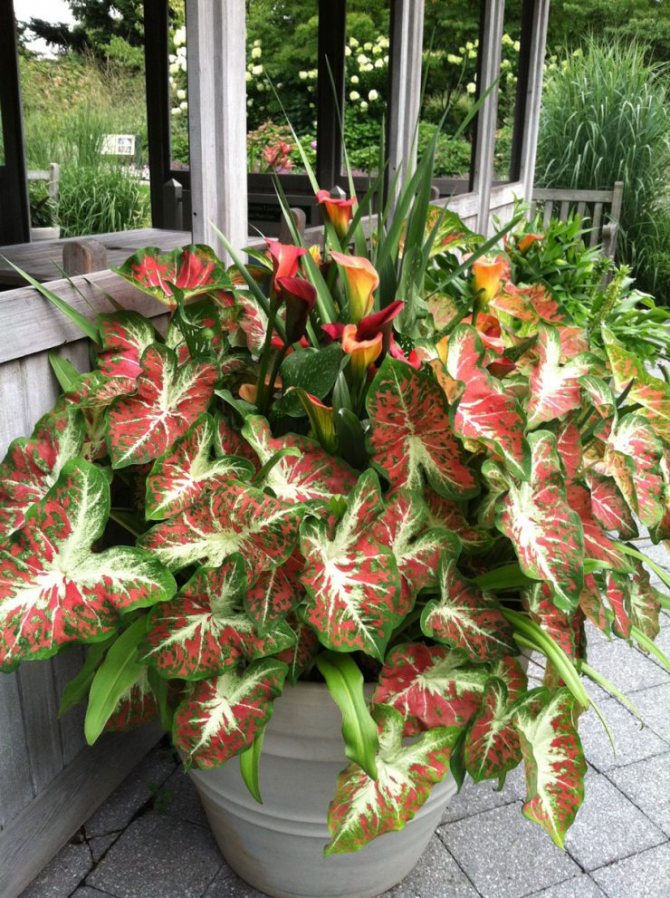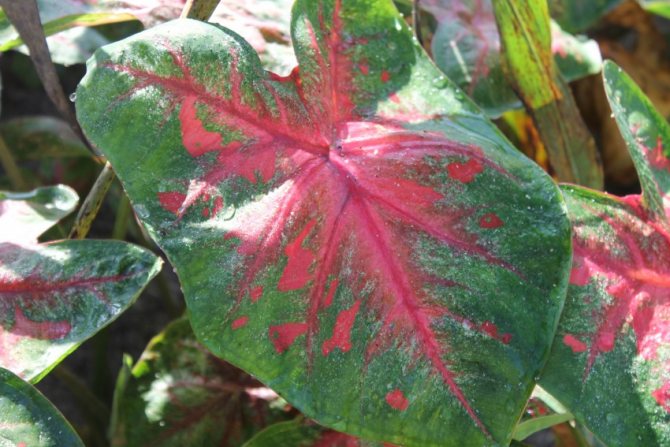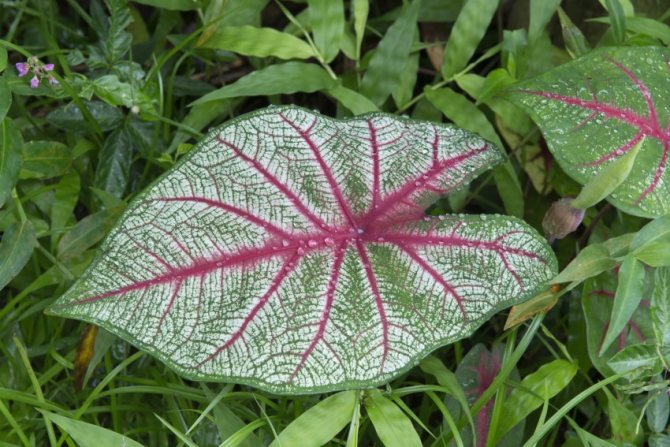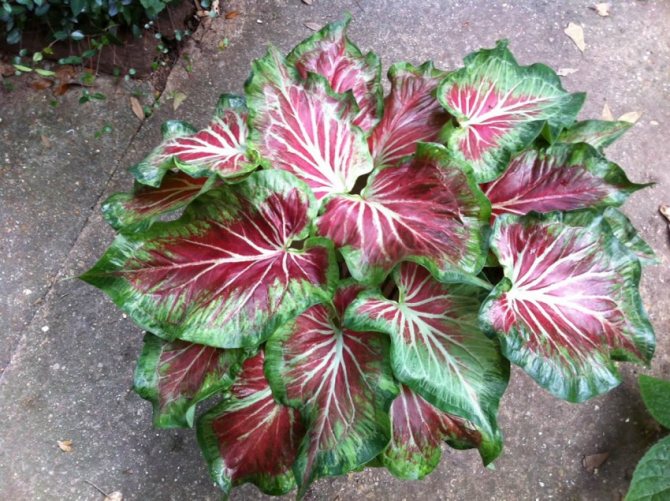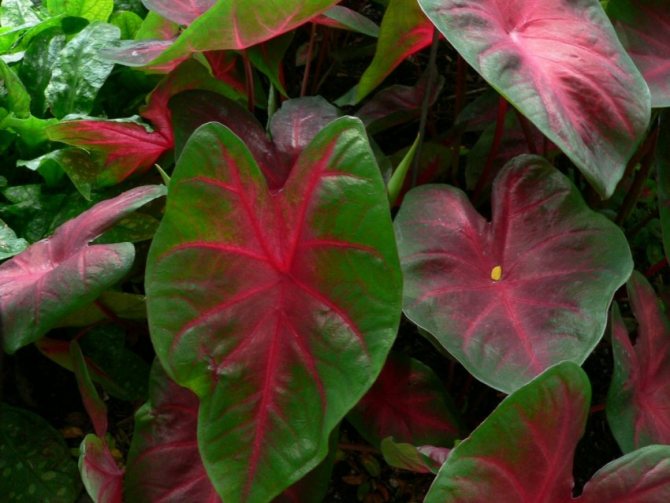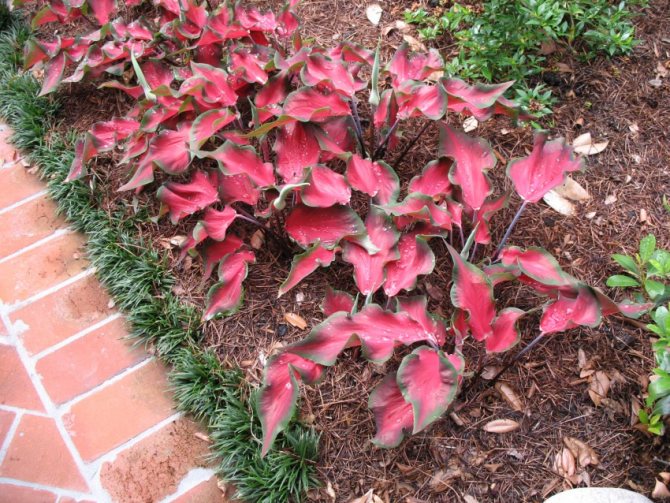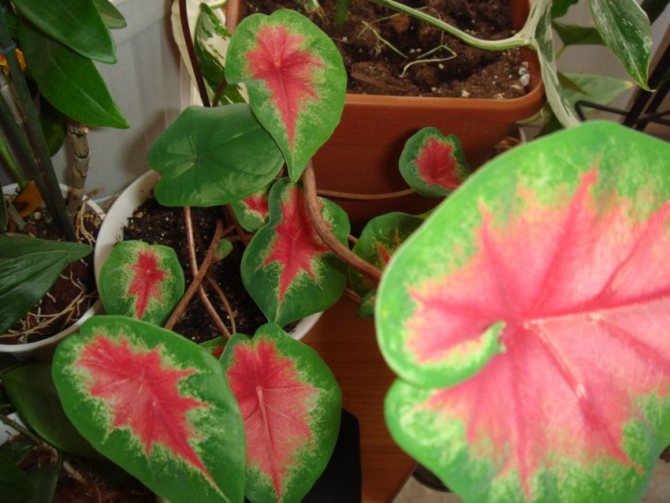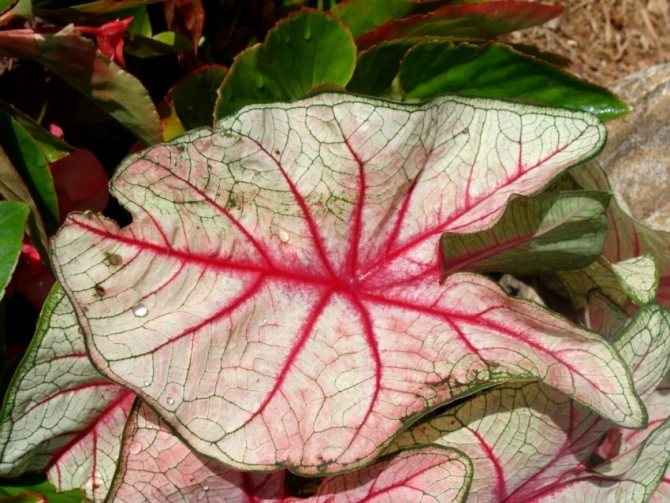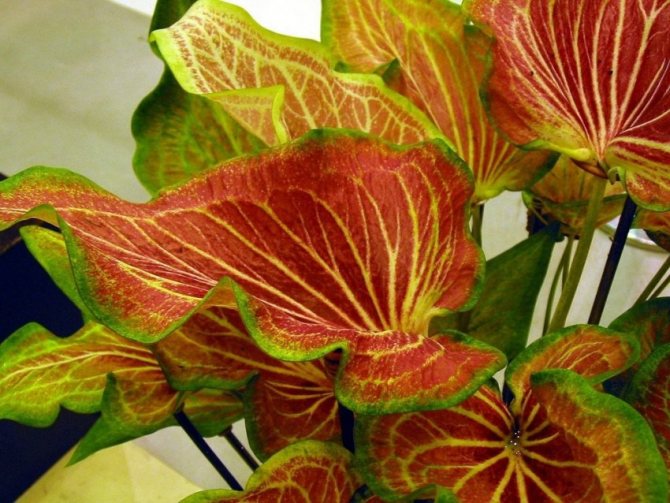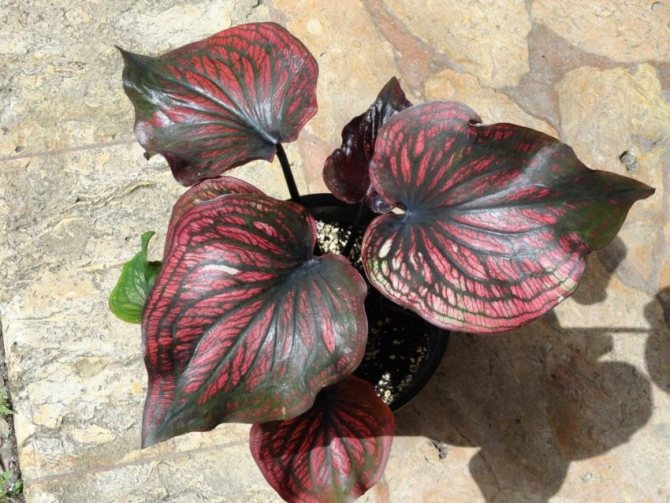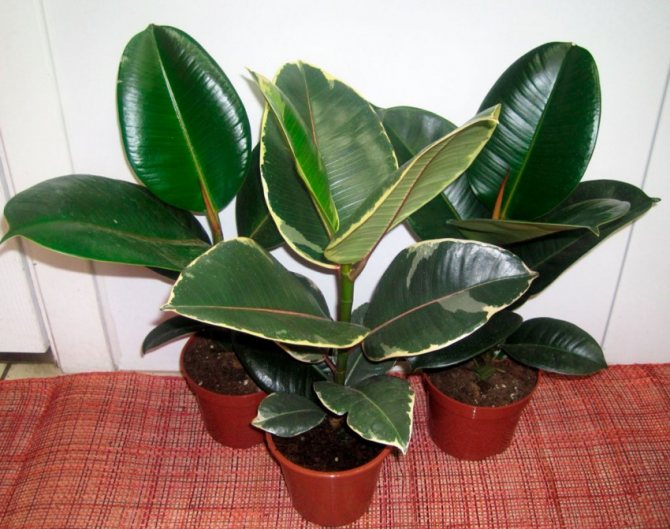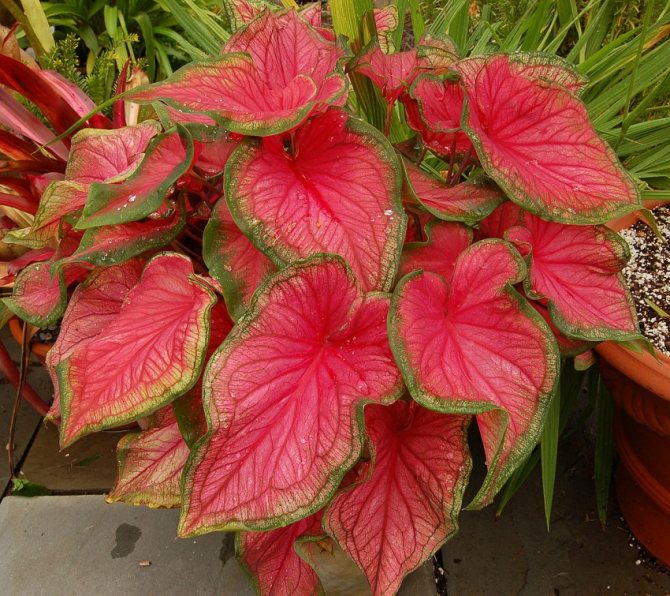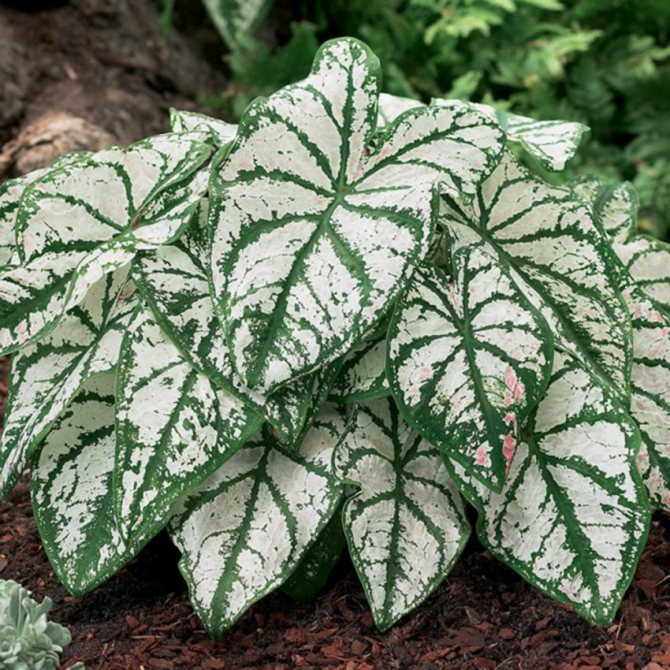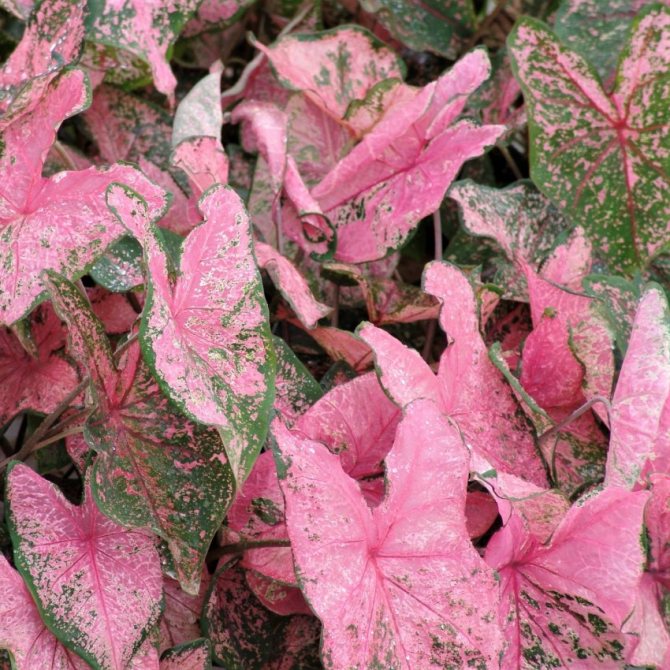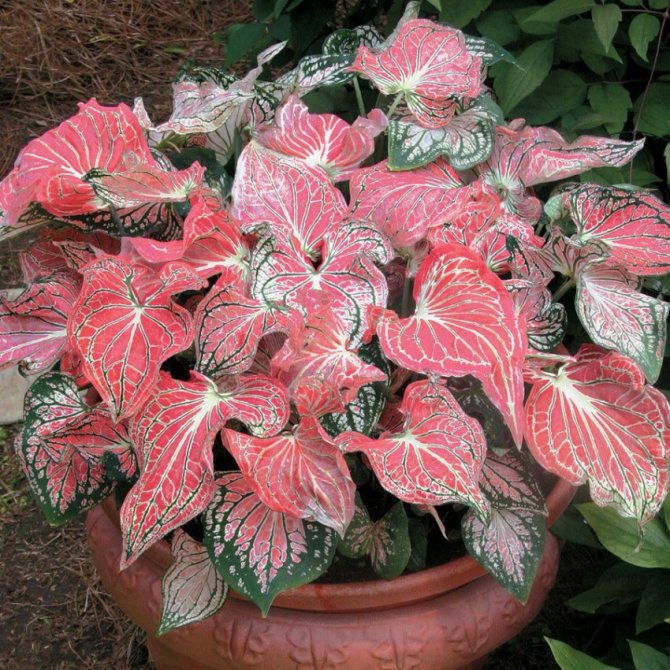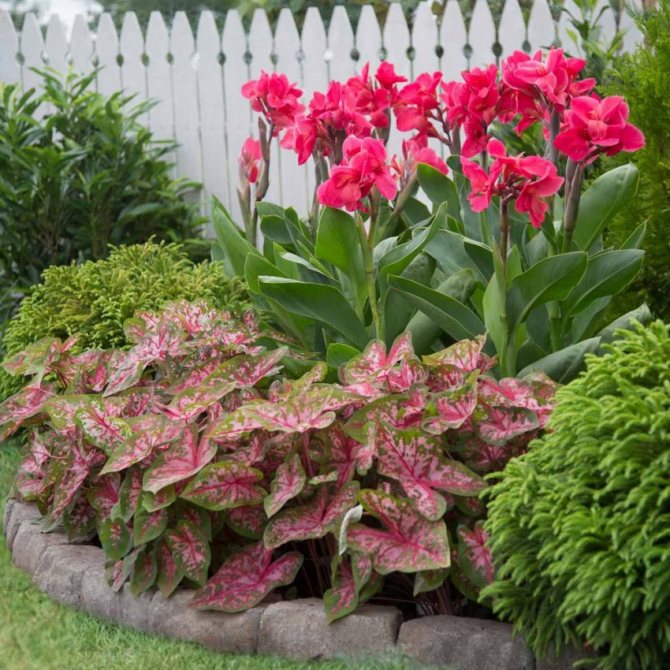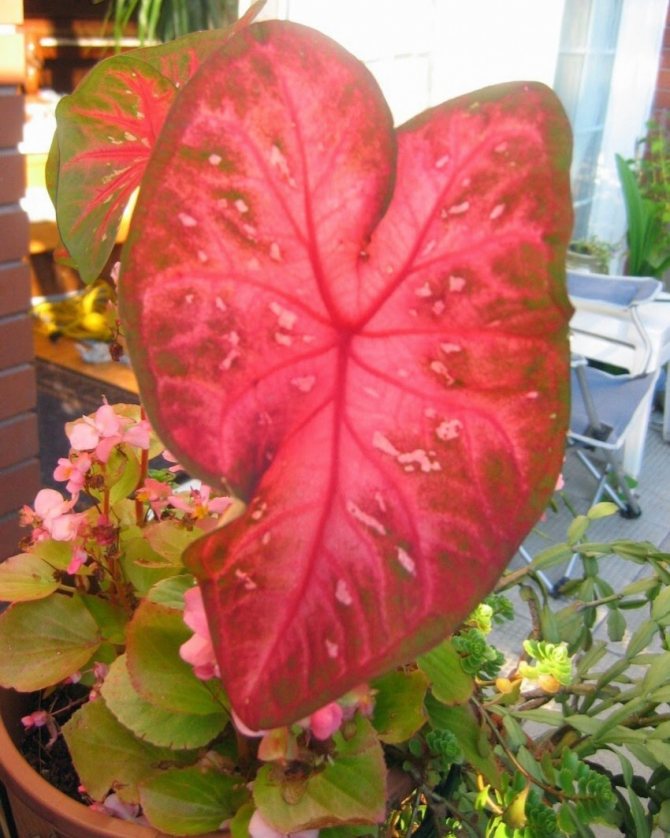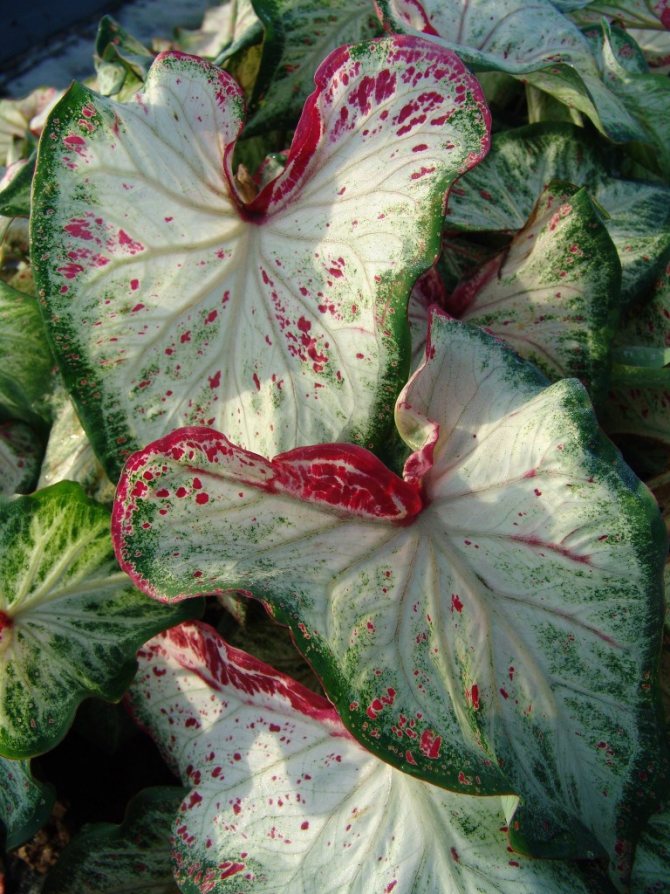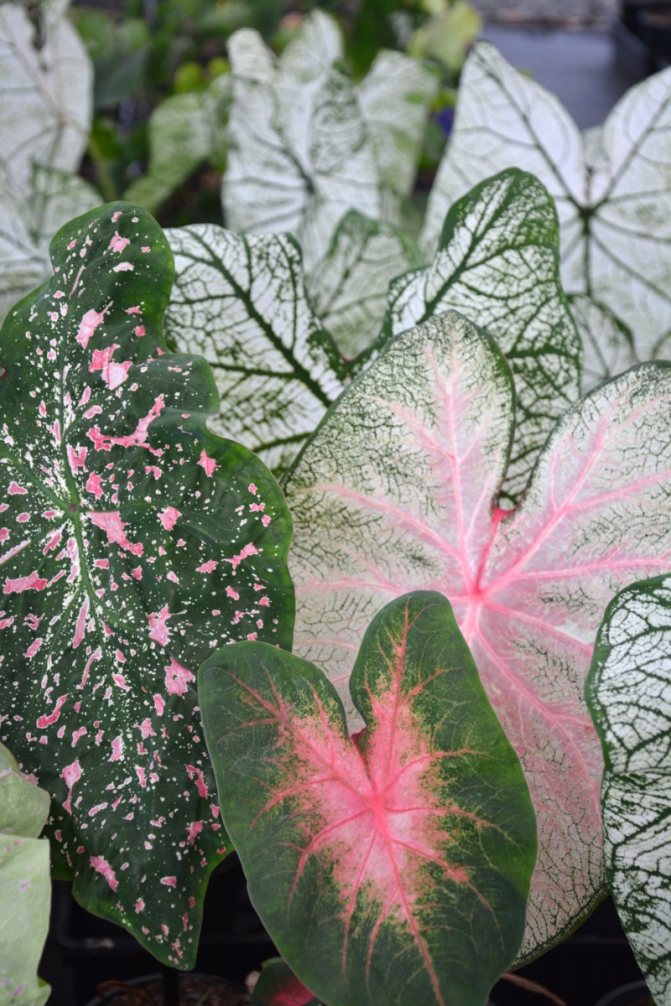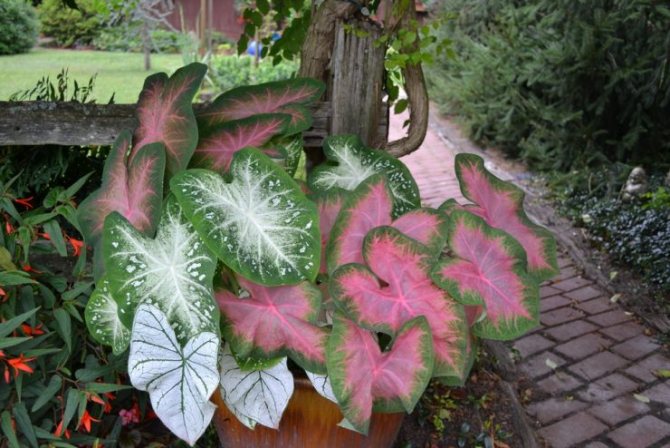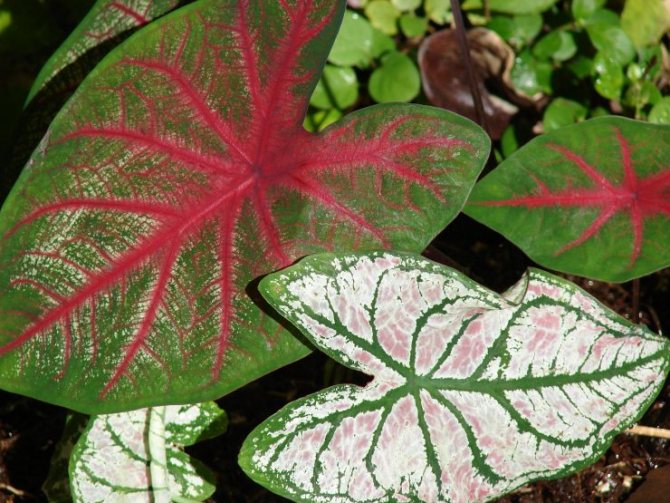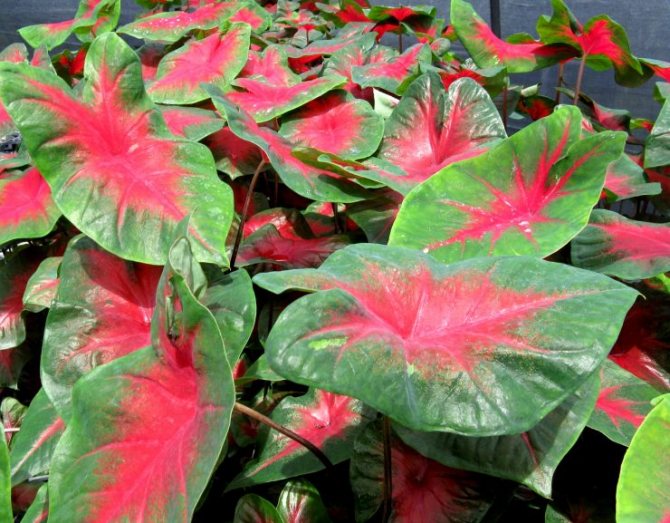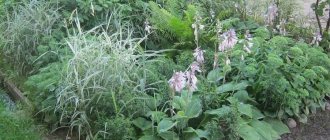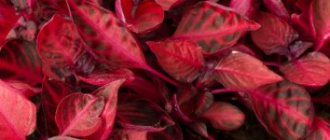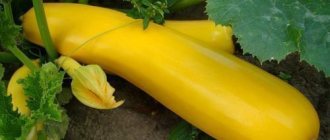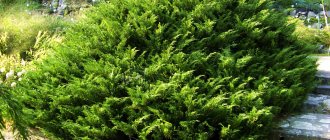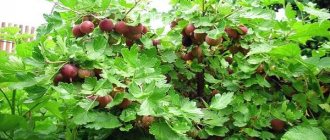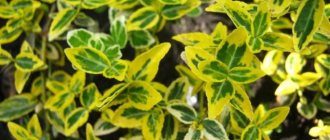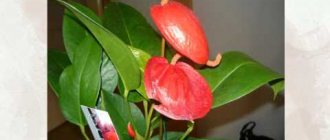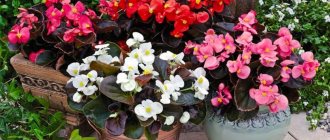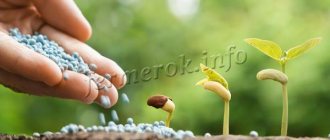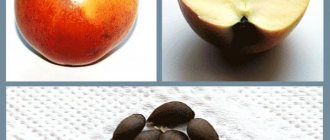Caladium (Caladium) - deciduous indoor culture from the Aroid family. In nature, it is common in the tropics of South America and India. Caladium gained popularity as an indoor flower for its incredibly beautiful light green leaves with various stains, spots and a contrasting pattern. For the unusual color and shape of the leaves, the culture in nature is called "Angel Wings", "Heart of Christ" and Elephant Ears.
Caladium shoots are very thin, most often basal, arrow-shaped or cordate. The plant requires careful attention and some care. Indoor caladium does not grow too quickly - during the growing season, from 10 to 12 leaves appear, and the flower itself reaches a height of 30 to 60 cm, and in nature the culture grows up to 5 meters.
The peculiarity of cultivation is the seasonal dormant period, during which the caladium completely loses its leaves and "freezes", therefore it is most often grown as an annual.
| In one year, the plant adds 10-15 leaves. |
| At home, it almost does not bloom. |
| The plant is easy to grow. |
| Up to 3 years old. |
Caladium care and maintenance
Lighting: The plant needs constant moderate light, otherwise the color saturation is lost, and insufficient lighting can destroy the plant. The east and west windows are well suited, where, with the onset of spring, active growth is read. For wintering, Caladium is placed away from drafts and cool air. When placed on the south side, it is necessary to take care of shading from direct sunlight at lunchtime.
Temperature: The optimum temperature is 22-25 degrees. The flower is quite thermophilic and even during the dormant period, the temperature should not fall below 18 degrees.
Humidity: In its natural environment, caladium is adapted to a humid climate, therefore, the humidity of the room should not fall below 70%, otherwise the millet plant will not be able to exist. At 90% humidity, the flower feels great. Regularly during the period of active growth, it is necessary to additionally moisten the plant, but when spraying, water should not fall on the leaves themselves, otherwise spots will appear and decorativeness is lost. As an additional humidifier, place the pot on a pallet of moistened expanded clay or pebbles.
Soil: The following soil components are recommended: Peat, humus, leafy soil, 1 part of each component and 0.5 hours of sand. Mix everything. The soil should preferably be neutral acidic (pH = 6).
Watering: During the period of active growth, the plant needs abundant watering. Water is used soft, or at room temperature. The soil should not dry out, as soon as the top layer dries up, watering is performed. At the end of the growing season, as a rule, at the end of summer, watering is gradually reduced. West is a dormant period, watered very rarely, when the ground dries out very much, in order to avoid shrinking of the tubers. Starting in spring, watering is gradually increased as the leaves grow.
Transplant: Start transplant after swelling of the kidneys, at the end of February. The tuber has a direction, if planted upside down, the first shoots will appear much later. Also, the deepening of the tuber into the ground affects the growth and power.With a large deepening, there are fewer shoots, but the leaves will grow large and vice versa, planting at the very top, the flower will be lush, but not so majestic.
The soil is used from the following components: turf (1 h), peat (1 h), leaf (1 h), sand (0.5 h), or buy ready-made for decorative non-flowering plants.
Previously, a layer of expanded clay is laid on the bottom of the pot as a good drainage.
Reproduction: There are two methods of propagation: tubers and seeds.
- Seeds. The flowering period of Caladium is very short. After the appearance of the 3rd leaf, the flowering process begins and lasts only a few days, but the seeds themselves will ripen after 2 months. After collecting the seeds, they are sown in the soil from leafy soil and peat in equal amounts. The first shoots will appear in 3 weeks. Through the summer, tubers are formed.
- Tubers. In early spring, the tubers are divided into parts, but at least one bud must be present. Place the cut, sprinkle with charcoal to avoid decay. They are planted in the ground from a mixture of sand and peat in equal amounts. After planting, the pots are placed in a well-lit area, smooth, moderate watering begins and the temperature is kept at 22-24 degrees.
Top dressing: Fertilizers are used purchased on a mineral basis for ornamental flowering plants. Fertilize once a week and only during the period of active growth. At the end of summer, they stop feeding.
Dormant Period: Beginning in autumn, the leaves dry up and a dormant period begins for Caladium. Watering is practically stopped, I leave the tubers in dry ground. Only starting in spring, watering is resumed. It is better to keep the tubers in the sand during the dormant period. The temperature is kept at 18-20 degrees. With the beginning of spring (late February), the tubers are separated by size and planted in the above-described soil composition. I start with moderate watering and after a few days, the first roots will appear.
Pests and Diseases: Often the plant is resistant to pests, but can be affected by aphids.
Excess moisture during the rest period is a danger. If rot appears in winter, carefully cut it out, and sprinkle the place with charcoal.
During active growth, on the contrary, insufficient moisture (weak watering) and low temperatures are detrimental to the plant.
Danger: Caladium juice is poisonous and, if it comes into contact with the skin, causes redness and scabies, it is especially necessary to be especially careful in an apartment with small children. Ingestion, may cause choking, fever and allergic reactions
Photo gallery
Reproduction and cultivation
Thuja review of the most interesting varieties
At home, caladium from seeds is grown only from seed purchased in specialized stores. On domestic plants, seeds rarely ripen, seedlings from them are obtained completely different - maternal traits are lost. Daughter tubers are used for flower propagation.
- Planting with seeds. Seeds are sown in light soil, moistened with a spray bottle. The container is covered with glass, kept at a high temperature of 25-30 ° C. Regularly moisten the soil surface, arrange short-term ventilation. Entrances are expected in 15-20 days.
- Daughter tubers. In early spring, before planting, the tubers are cut into several parts. Each part should have one shoot (bud). The process resembles cutting a potato with eyes. The sections are immediately covered with charcoal powder. The tubers are harvested in a shaded, well-ventilated, dry place for 2-3 days. Planting without drying threatens with rotting tubers. Tubers are planted in separate pots, watering is stopped for a while. Before the emergence of sprouts, the soil is not allowed to become waterlogged.
Reproduction of caladium
Caladium multiplies easily and every year you can get a new plant with beautiful leaves.
Reproduction of caladium tubers
The most common breeding method for caladium is tuberous.The bulbs can be bought in specialty stores or obtained from maternal asthenia by dividing. Before planting, the tuber is examined for the presence of diseases and pests, decay and the appearance of mold. An adult plant produces "babies" - small bulbs that are easily separated and used as seed.
If there are no "children", you can divide the maternal tuber, but each part must have 2-3 buds. Bulb slices are treated with charcoal to prevent decay. In the prepared substrate of sand and peat, lay the tubers cut down and sprinkle with the remaining soil so that they go deeper by 4-5 cm.
Growing caladium from seeds
Seeds of the tropical "handsome" are purchased in shops for florists. For planting, a light, loose, moist substrate is used, which is poured into a shallow dish and the seeds are buried so that the height of the soil above them is equal to the size of the tuber itself. For better germination, use a "greenhouse" - just cover the planting with foil or glass.
A container with seeds is installed in a warm place where the air temperature does not drop below +23 degrees. As soon as fresh shoots appear, they are regularly sprayed with water at room temperature from a spray bottle. It takes 3-4 weeks to germinate seeds.
The best time to breed is late February or early March.
Rules for feeding and watering Caladium
Hoya flower types of hoya that can be kept at home
Caladium requires abundant watering during the period of its most active growth, especially during the summer.
Large leaves need a huge amount of moisture, otherwise, with a lack of water, the leaves will lose their decorative appearance. Humidify the air around the Caladium, creating a "fog" effect.
But don't overdo it! Too large drops do not dry out for a long time. Brown spots may appear in place of these drops. At the end of summer, the frequency of watering is reduced, and when the caladium sheds its leaves and goes "to rest", watering is stopped.
During the "sleep" period, you can slightly moisten the soil with a spray bottle so that the roots do not dry out.
To feed the plant, mineral fertilizers are used, which contain phosphorus, nitrogen and potassium. It is best to feed Caladium during the period of active growth, every 3-4 weeks.
Important! Caladium, which is just "waking up", should be watered sparingly. Before the leaves appear, the plant does not require a lot of moisture.
Fertilization
It is necessary to start feeding Caladium in June, after the shoots stop growing. The plant needs balanced chemical fertilizers, which should include phosphorus, potassium and nitrogen in equal parts. Organic fertilizers include manure, dung, compost, humus (contain nitrogen), and wood ash is rich in potassium and calcium.
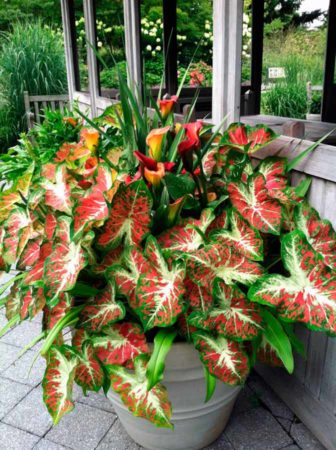
It is recommended to use universal mixtures for decorative deciduous plants (such as Bona Forte, Agricola Aqua are suitable). It is necessary to dilute in accordance with the instructions, a lower concentration is allowed. It is necessary to add nutrients alternately 1 time per week throughout the growing season. From August until the next season, it is not required to feed the flower.
Excess nitrogen leads to a color change - green will prevail over red.
Caladium. Views.
Four reasons to grow Asparagus pinnate at home
There are a lot of Caladuim varieties, they were obtained by interspecific hybridization. To create varieties, mainly three types were used, more about them. It should be noted that the taxonomy of caladiums is rather confusing. It happens that the same species is found under different names.
Caladium Humboldt (Сaladium humboldtii)
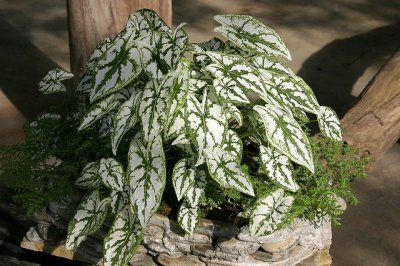

This species has a large number of leaves, the leaves are not large - 8 cm in length and 5 in width, their dark green color is diluted with gray or white spots, stripes and strokes.
Caladium bicolor (Caladium bicolor) or Arum bicolor (Arum bicolor)
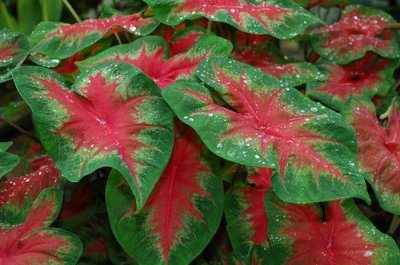

This species also has numerous leaves, but they are larger than the previous one, reaching 12 cm in length, sagittate or ovate-heart-shaped on long petioles, bluish-green with light and red spots of various sizes. This species has flattened round tubers.
Caladium schomburgkii
Plants belonging to this species have elongated oval leaves, at the base they are weakly cordate. Reach up to 15cm in length and 13cm in width. Red at the tip, brighten towards the base. There are white and gray spots and streaks on the leaf plate.
Types of home caladium with photos and names
There are more than 15,000 species and varieties of this magnificent plant in the world. But in indoor floriculture, only a few are easily adaptable.
Caladium bicolor
The most common type among florists. The leaves of Caladium Bicolor have a rich green color with a pattern of white veins, stripes and specks. The edge of each leaf of the plant is framed with a dark green border.
Caladium Humboldtii
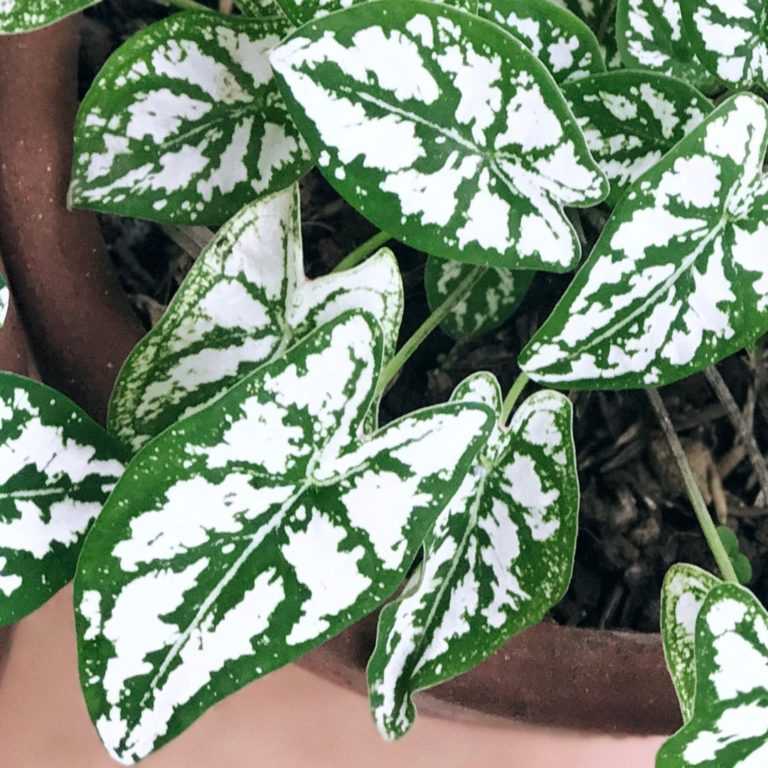

This species is easy to reproduce, forgive others tolerates changes in climate and irrigation regime. Leaves are thin, may vary in color intensity. Most often they have white and even silvery spots and stripes on a dark green background. The plant is compact, easy to multiply. With the right lighting, you can achieve the splendor of the leaves even in winter and avoid a dormant period.
Caladium planting and care at home
Alas, but I have to start tips on growing this flower from a not entirely pleasant moment ... The fact is that caladiums sold in flower shops can be, of course, very beautiful, but in most cases this beauty is short-lived, and the plants themselves are extremely short viable. It is quite natural that the almost inevitable change of conditions from greenhouse to domestic stress for any plant, and caladium is one of those plants that tolerate them especially hard. It goes without saying that to give the plants a presentation, they are pumped with various stimulants, which weaken the plant and make it virtually an annual. Therefore, if you want to grow a beautiful, strong plant that will delight you for more than one year, buy not a ready-made plant, but a caladium nodule.
Indoor varieties
Crossed and hybrid varieties are sold in modern flower shops. They are much more interesting and decorative. Housewives prefer to keep the Caladium on a loggia or a glassed-in veranda.
However, despite all the merits of the breeders, the plant has not won a special favor among amateur flower growers.
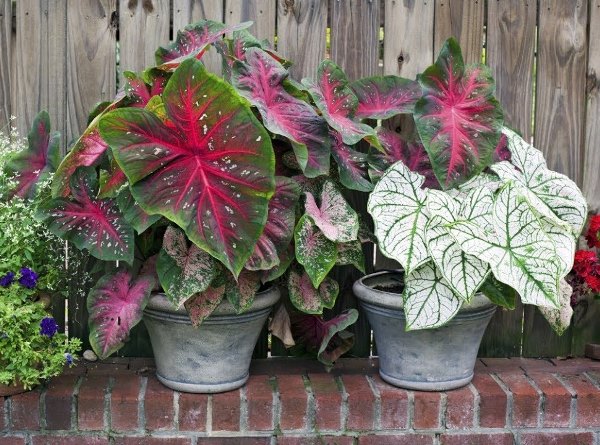

This is due to the long inactivity of the flower: from the first autumn days, the caladium begins to lose leaves and goes to rest until mid-February.
Important! Care should be taken for those who suffer from allergies, since the juice of this plant is a very strong natural allergen, moreover, poisonous. For the same reason, you should not place it in the kitchen or in the nursery.
Plant care at home
It is not very difficult to care for Caladium at home. Alas, the flower pleases with beautiful foliage for only a few months, but even after that, during the dormant period, it also needs care.
In early spring, the tubers are transplanted. The pot should be suitable for the size of the nodules. The smallest ones can be planted in several pieces in one pot, but you need to leave room for them to grow. The pink dot on the tubers should be on top. To get a large spreading bush, the nodules are planted to a depth of 5-10 cm.
It is best to take special potting mixes for caladium. They are distinguished by their light structure and high water permeability.The acidity of the soil should be neutral. The composition usually includes humus and leaf soil, peat, river sand and some charcoal.
Caladium lighting needs intense but diffused lighting. The more variegated the foliage, the more light is needed. Direct sunlight quickly causes burns. As a result, ugly brown spots appear. It is best to place caladium pots on either east or west windows.
The optimum air temperature is + 22 ... + 27 ° C. Cooling below + 20 ° C is undesirable at any time, even during the rest period.
Caladium can adapt to normal indoor humidity. He will respond gratefully to spraying. Lack of moisture leads to drying out of the leaves and a decrease in the growth rate. If necessary, pallets with wet expanded clay are placed near the bushes.
Caladium loves regular watering, but in small portions so that the water does not stagnate in the ground. The top layer of the earth should dry out between waterings. Since August, when the leaves begin to die off, watering is reduced and gradually stopped completely. During the dormant period, irrigation of the soil with several spoons of water is allowed
In the spring, with the appearance of sprouts, watering is increased, but very carefully
Caladium fertilization begins in June, when the bulk of the leaves have already appeared. Every week, a solution of mineral dressing with a high content of phosphorus, nitrogen and potassium is poured into the ground. Fertilizers have been stopped since August.
Watering
The tropical flower loves regular watering. It is recommended to carry it out in small quantities, avoiding stagnant water. The need for irrigation can be determined by the drying out of the top layer of the earth. Abundant watering begins after the emergence of shoots and decreases in August. During hibernation, spraying is necessary so that the tubers do not dry out.
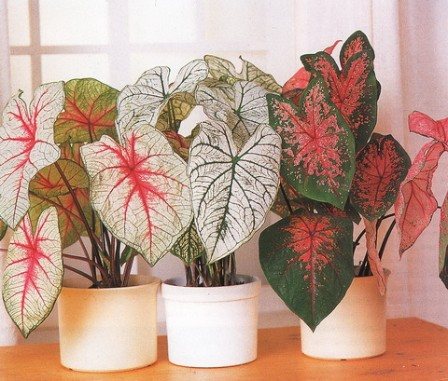

The water needs to be soft, its temperature should be slightly higher than the environment.
Variety collection
At home, there are up to 15 popular varieties of the caladium flower. Each of them differs in appearance, tubers, and conditions of detention. Here are some of the famous varieties.
Schomburg
The shape of the leaves weakly resembles a heart. The plate is 15 cm long and 12 cm wide. Their base is oval or elliptical.
Bicolor
People know it as two-color arum. The unmatched combination of two contrasting shades of red and green makes the triangular-shaped leaves the highlight of the greenhouse. At the same time, there are varieties with white pigmentation.
Large leaves look elegant on thin stems. They are 10-19 cm wide and over 30 cm long. This decorative caladium flower will perfectly fit into an empty corner of the living room.
Humboldt
As the name suggests, a complementary color to dark green is the metallic shade of silver. Shapeless spots of various calibers serve as a pattern. The central and lateral veins are always green.
At the peak of growth, the length of the leaves of this type is 8 cm, and the width is 5 cm. They are ovoid with a built-up edge. Since the foliage is small, one pot can fit from 10 to 25 units.
These are the most famous and common varieties. In addition, rare, but at the same time more luxurious species were bred. Among them there is a Caladium, some photos are shown below:
- Florida Sweetheart, Sunrise and Red Ruffles.
- Carolyn Worton.
- "Pink Beauty".
- Fanny Manson.
- "Candy land".
- Scarlet Pimpernel.
- Rosalia.
The "Florida" variety is distinguished by the oblong shape of the leaves. Scarlet streaks are a characteristic feature of the group. A unique species of the Aroid family is Rosalia. The glossy brownish-red surface with dark edging makes this flower an elegant look.
As noted, these exotic varieties are very finicky.
Thus, it is important to know some of the features of planting, as well as caring for Caladium.
Landing in the ground
Landing in open ground is carried out in a shaded area. In this case, the soil mixture should consist of:
- Humus.
- Leafy land.
- Sand.
- Sod land mixed with charcoal.
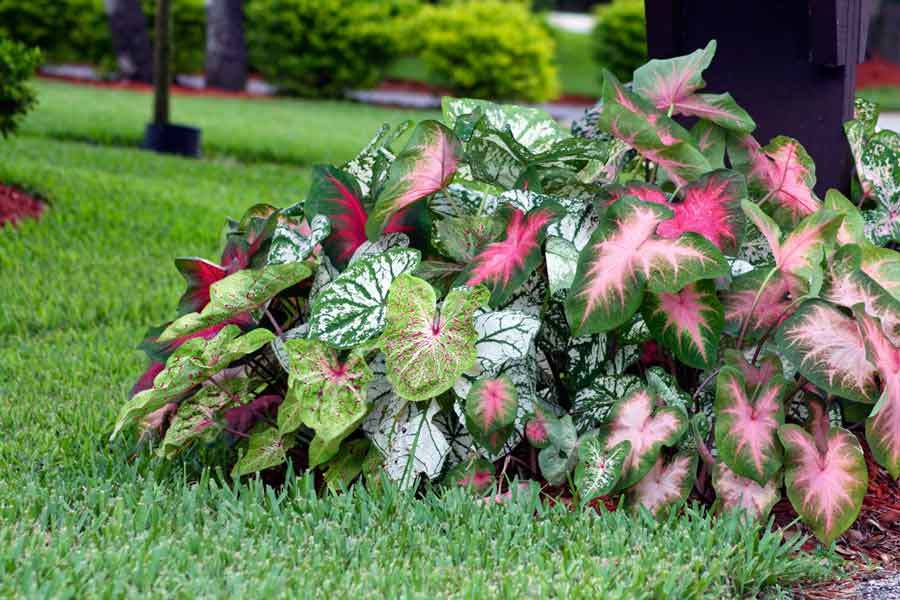

Growing caladium outdoors is possible only in the southern regions.
DESCRIPTION OF CALADIUM
Caladium is a perennial herb with arrow-shaped leaves, large and juicy. The veined leaves are the most delicious thing about this plant! The leaves grow from the very root, but the plant has no stem. In nature, caladium grows up to five meters, and the width of its leaf plates reaches thirty and even fifty centimeters.
The leaf plate of most species has a double color. The most common colors are magenta, white, yellow, green, red. There are shades of silver, pink, beige and others (except, perhaps, blue and blue).
It is the shape of the leaves that is the reason why the people call the Caladium "elephant ears", "angel wings" and even "Christ's heart". Flowers appear on it in summer, outwardly resemble nondescript lilies. Unisexual, have no perianth, collected on the cob, surrounded by a white veil. The fruit of the plant is a broom with berries.
CALADIUM CARE
The dormant period for Caladium begins in November and lasts until the end of winter. During this period, the tubers of the plant should be stored in a pot, in a dark room, the temperature in which does not rise above 13-16 ° C (although many argue that the tubers are perfectly preserved at a temperature of 18-20 ° C). A pantry or even a place under the bed is suitable for this. If the soil is too dry, the plant can be lightly sprayed.
With the onset of spring, the first shoots appear on the tubers. Now the plant needs to be removed from the pot, carefully cleaned of last year's roots and planted in a small pot (7.5-9 cm). As for the soil, it is best to mix turf soil with peat, humus and sand (proportion 1: 1: 1: 0.5). If possible, add bone meal and sphagnum, and then put the pot in the light at room temperature (from 23 to 25 ° C).
The first time should be watered sparingly, and after good roots have formed, abundantly. During the growing season, the plant needs to be fed
It is very important to monitor the humidity of the air and not to forget that the caladium is a tropical plant, and therefore loves high humidity.
When the caladium grows up, it should be transferred to a larger pot. When is the best time to do this procedure, the plant itself will tell you. How? Roots will emerge from the drainage hole. To prevent the leaves from turning pale, the flower pot should be placed in a bright place, but the sun's rays should not fall on it. The more light around the flower, the brighter the color of its leaves. By the fall, caladium is watered less often, in November they completely stop watered and, finally, the plant is removed to rest. This flower can multiply both by seeds and vegetatively.
Caladium is a plant that can decorate any home. He, like a magnet, attracts admiring glances. However, the juice of this beautiful plant is poisonous. Most often it causes allergies, but sometimes it causes a sore throat, swelling of the tongue and, as a result, respiratory arrest. Therefore, where there are small children or pets, you need to be especially careful with this beautiful, but unsafe plant for health. Even an adult caring for Caladium should take safety measures. It is better to take the plant in your hands with gloves.
If you follow the rules for caring for a flower, it will certainly reward its owner for patience and work with elegant caps of leaves of a unique color!
A beautiful and clean home requires the same attention as houseplants.
Soil selection
Caladium substrate needs lightweight, with good oxygen access to the roots.Ready-made soils for dieffenbachia and spathiphyllum are suitable. The optimum acidity level is around 6 pH. You can make a soil mixture at home from the following components (in a ratio of 1: 1: 1: 0.5):
- peat;
- leafy land;
- humus;
- sand.
To prevent the occurrence of rot, the bottom of the pot must be drained by 1/4 of the volume. You can use expanded clay for this.
To get rid of pests before planting will help treat the soil with a solution of potassium permanganate or copper sulfate.
Botanical characteristics
Caladium is a herbaceous perennial plant with a tuberous root system. The rough flattened tuber is 7-10 cm in diameter. Several growth points are visible on the upper part. A fibrous root system develops from the lower part of the tuber.
The life cycle of the Caladium is divided into periods of rest and active growth. From the end of August, all of its grassy growth begins to dry out. Only tubers are preserved until March. In early spring, young shoots appear from the ground.
Caladium leaves on long fleshy stalks grow directly from the tuber. In a natural environment, the height of the bush can reach 5 m. Indoor plants are 40-90 cm in height. The arrow-shaped or heart-shaped leaf plate has a contrasting color. The length of the leaf is about 30 cm, and the width is 15 cm. Since the leaves are the main decoration, there are many types and varieties of plants with a wide variety of colors. Foliage is raspberry, silver, pink.
In late spring, after the appearance of the first 4 leaves, the inflorescence begins to develop - an elongated ear of a light yellow hue. He is surrounded by a white and green veil. The flowering is practically not accompanied by aroma and lasts only a few days. After pollination, dense spherical berries ripen. In indoor conditions, flowering and fruiting occurs extremely rarely.
Preparing for winter
When the "hibernation" period begins, the leaves of the plant completely dry out. This happens around October. Caladium tubers must be carefully removed from the pot and follow these steps:
- remove soil debris, dried out root shoots and, if present, any damaged areas;
- dry the tubers in the open air;
- sprinkle damaged and cut areas with activated carbon;
- fold the tubers into dry moss or vermiculite and store at about 18 ° C;
- water the tubers periodically to prevent them from drying out.
Spectacular caladium and its types
Caladium
(Caladium) belongs to the Aroid family and is a genus of 16 species. These are tropical plants native to the forests of Central and South America.
Caladiums
Are tuberous perennials with bright and rather large heart-shaped or arrow-shaped leaves.
The translation of the name of this representative of the flora reminds that the natives consider it "a plant with an edible root." And another popular name for the plant is "elephant ears".
By form caladium tuber
resembles a dark brown cone, and with age - a turnip with a diameter of no more than 10 cm.
In the center of the tuber there is a powerful base of the bush, and on the sides there are dormant buds. Caladium roots growing from the root collar are fibrous and strong.
The plant has no
stems - its leaves are formed directly from the bud and grow on long petioles. Rosettes of leaves can form bushes, the diameter of which reaches 90 cm. At home, the height of a caladium bush can be from 30 cm to 1.5 m. On average, a plant lives in an apartment for 2 or 3 years.
Leaves by shape
are like an arrow, and their base is on the heart. The leaf blade, which can be 20 to 45 cm long, is thin and leathery. Caladium leaves can have a wide variety of colors, and the veins on them, as a rule, are contrasting and clearly expressed.
When 4 leaves appear on the plant, you can expect flowering
... A modest inflorescence in the form of a white cob, covered with a white or green veil, stays on the plant for several days. Round berries ripen on Caladium 2 months after pollination.
As a rule, in home floriculture, you can find only hybrids of the main species, which are very interesting varieties. Species caladiums
are considered only as the original representatives of the genus, and they are interesting in their own way:
Caladium Humboldt
(Caladium humboldtii), also called
caladium myriostigma
(C. myriostigma) or
Caladium Argintes
(C. Argyntes) is a native of Brazil with arrow-shaped leaves up to 10 cm long, characterized by a dark green surface with silvery spots.
Caladium bicolor
(Caladium bicolor), also called arum bicolor or Arum bicolor, is a species that came to us from the Antilles and from the mountainous regions of Brazil. Interesting arrow-shaped leaves up to 30 cm long, color, which varies from green to red, and spots of all kinds of colors and shapes.
Caladium Schomburg
(Caladium schomburgkii) - a plant native to Brazil and Guiana, distinguished by red oval leaves up to 15 cm long with silvery areas between the veins. There are variations with coloration and veins of various colors.
Most beloved by flower growers hybrids
caladium
- this is:
- Sea gull
- variety with green leaves decorated with white veins. - Rosalie
- a plant with red leaves and a thin or wide green border. - Pink blush
- Caladium with dark pink or dark red leaves and a green rim. - Pink beauty
- a variety with red veins, a pink central part and a green border. - Carolyn whorton
- a plant similar to the previous variety, but there are slightly fewer green spots on its leaves, a pink tint prevails. - John Pul
- a plant with a red-green palette of leaves. - Pink cloud
- Caladium with red-green leaves, the color of which includes a transition from a red-scarlet center and white veins to a pinkish-green border. - Florida Cardinal
- a very effective variety with a raspberry center of the leaf and the same veins and a wide green edge. - Scarlet pimpernel
- a plant with rich red veins and the center of the leaf, surrounded by a light green area. - White christmas
- a magnificent caladium with dark green veins on the white surface of the leaf, decorated with dark green specks or without them.
Views
There are 15 types of caladium in total. The most common ones are - Humboldt and Schomburg. It was these two species that gave many varieties that were later bred by breeders.
Humboldt is a stemless plant with a rosette of arrow-shaped foliage 10 by 5 cm. A dark green leaf blade with silver spots in the middle is its classic appearance.
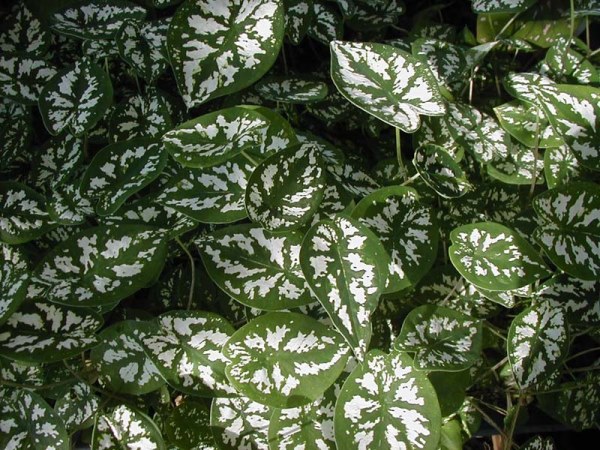

Schomburg is painted in a silvery-red scale with greenish veins, the rosette reaches 15 by 12 cm.
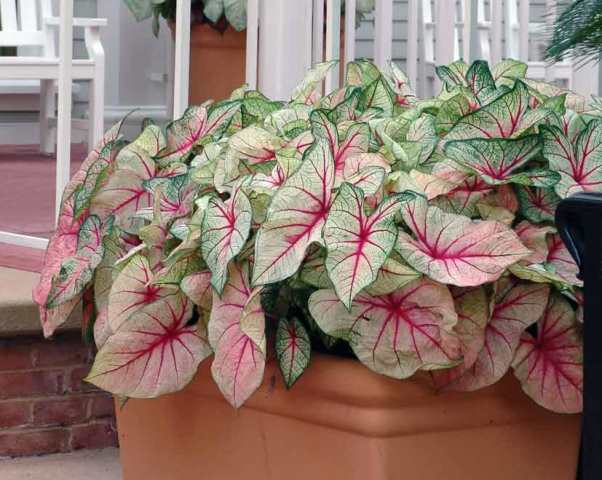

Caladium bicolor
A very beautiful, albeit rather capricious plant.
The leaves are narrow, arrow-shaped. From the central part of the leaf to the edges, a bright red blot spreads, sharply contrasting against a green background, hence the name - two-color. The length of the plate is 30 cm. This tropican is very demanding, and in a temperate climate it gives a lot of trouble.
Caladium esculentum
Has a larger size. Cuttings reach up to a meter and a half, and the leaf reaches 80 cm in diameter. The center of the leaf is painted in a cream shade, the edges are deep green.
Caladium Violaceum
The photo and description of this flower fully correspond to the name, which seems to hint at some color of the leaves: from the inside they are red or purple.
Caladium hybrid
An interesting combination: an almost white leaf, covered with red veins with a green netting. Gained great popularity and fell in love with many flower growers, including for its unpretentiousness.
Growing Caladium at Home
Those wishing to grow Caladium on their own need to know what kind of home care this culture requires. Since caladium is a variegated plant, it requires a lot of light.
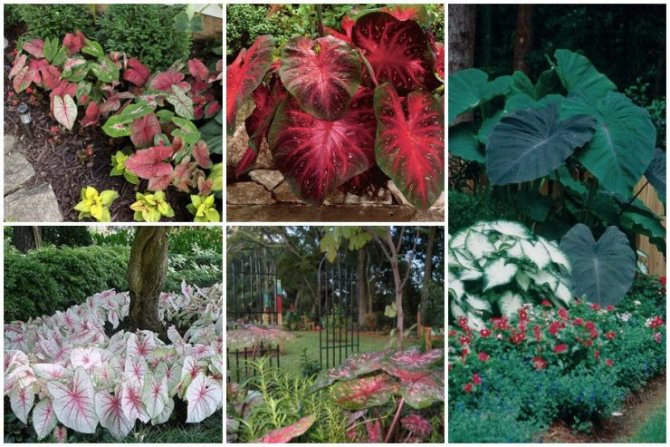

But direct sunlight can destroy it. In the usual, tropical conditions, caladium is protected from the direct rays of the crowns of other plants. To protect it from the scorching sun in the house, you need to choose the right location.
Pots with these flowers should be placed on windows facing either the west or east side. If this is not possible, and the plant is placed on the south window, it must be darkened. To grow caladium on the north window, you need to provide additional lighting.
Having a tropical origin, indoor caladium is highly dependent on factors such as air humidity. In summer, under natural weather conditions, he feels quite comfortable. But in the cold period, when the room is warmed up with the help of heating devices, it is necessary to make additional humidification of the air.
From the beginning of the emergence of sprouts, and before the caladium goes into hibernation, it needs abundant watering. Watering should be done at the first sign of drying out of the topsoil.
The lack of water instantly affects the leaves of the plant. They become lethargic and lose all their beauty. But you can't overdo it. Over-watering will cause root rot and plant death.
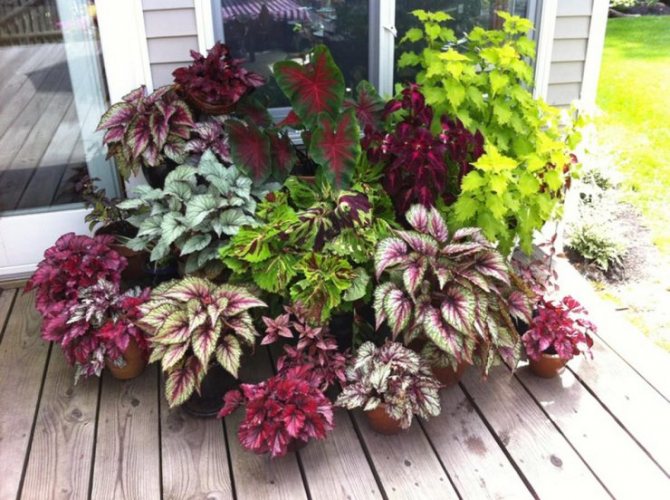

You need to plant a houseplant Caladium in a mixture of peat, humus and garden soil in equal parts.
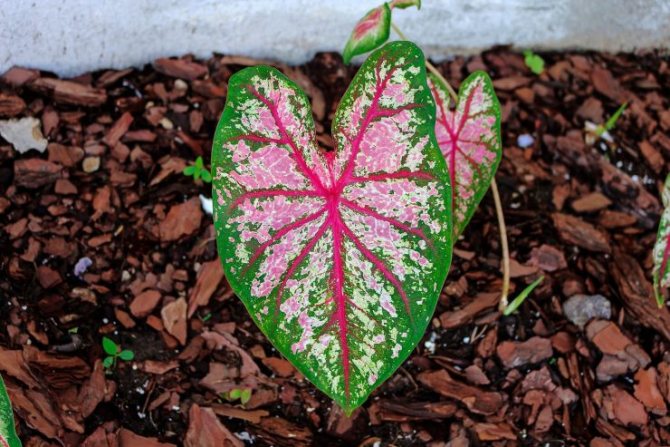

You can mix in a small amount of crushed coal, sphagnum and fine sand. The primer must be sterilized and laid out on a drainage layer.
Containers for caladium are selected depending on the size of the tuber. A pot of 10-12 cm in diameter is enough for a small one. A large tuber will require a container with a diameter of more than 20 cm.
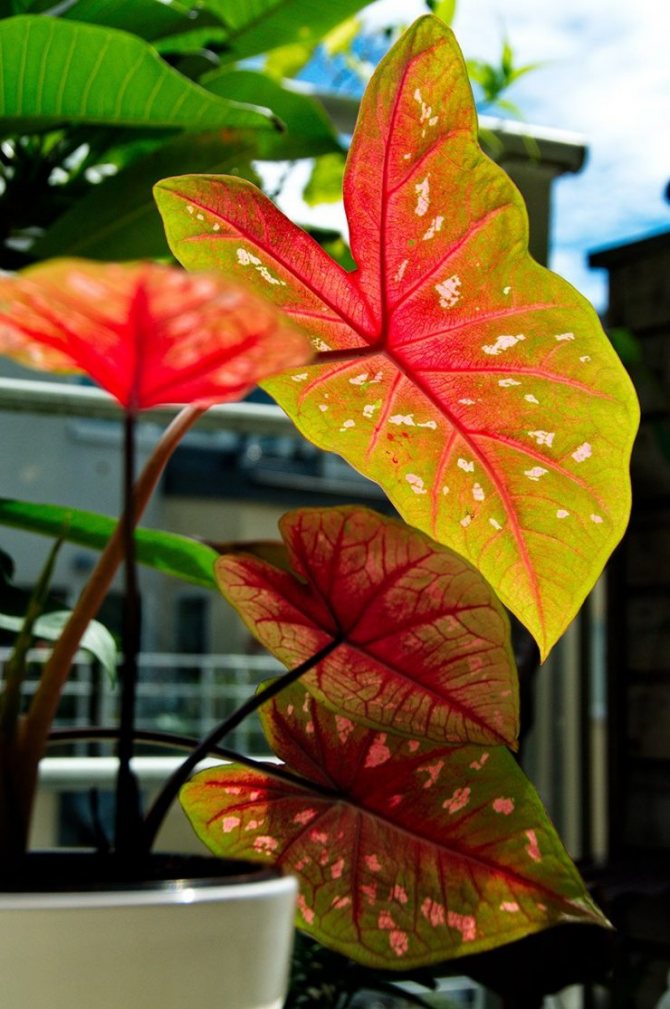

How to choose and buy Caladium
You can buy caladium in tubers, or you can buy it directly in pots in almost any flower shop or order it online. You need to choose a plant based on the tubers: size matters. It is best to shop in early spring when this flower begins its growing period.
If you bought a germinated plant, then it will need to be transplanted. In the store, it is better to get recommendations for caring for a particular variety: there are many varieties and their requirements are different.
Make sure the flower is healthy when shopping... There should be no rot, stains, plaque on it. The soil should be slightly damp. Swampy specimens are also not worth taking - most likely, the roots have already been struck by rot.
The same goes for tubers. They must be clean, free from stains, mildew and build-up. According to the teachings of feng shui, it is very useful to keep caladium in the house for lonely people, especially women, since aroids help to attract a soul mate.
Diseases and pests
During the growth and life of the plant, you may encounter small problems (but in general, the plant is not particularly problematic):
Roots can rot: they can start to decay during storage or during the growing season. A similar phenomenon is associated with the appearance of bacteria and fungal microorganisms. To prevent this phenomenon, we recommend that you choose disease-free tubers for planting and, during storage, monitor the level of humidity and temperature in the room (we remind you that the humidity should be at an average level, and the temperature should not exceed twenty degrees).
spots appear on the leaves: the appearance of the anthracnose fungus can contribute to the appearance of brown spots on the entire surface of the leaves. Here it is quite possible to do without the intervention of chemicals and simply remove diseased leaves.
leaf burning is the result of over-foliar feeding, lack of water, or excess sunlight. The older the leaves, the more they are susceptible to this disease.
Care features
Where caladium is located, it is necessary to observe the temperature range 18 ° C-25 ° C, and the humidity 70%. Do not spray the leaves with water. It is better to place a container filled with water next to the plant.
When the first leaves appear, the plant should be watered abundantly. This is done twice a day. In the summer, the volume of water for a single irrigation should be at least half a liter.Closer to autumn, when the culture is preparing for "hibernation", it should be watered sparingly, but at the same time, the soil should not dry out.
It is necessary to start feeding the plant with fertilizers in late May or early June. During the season, you will need to spend 2 - 3 feeding. Typically used as a nutrient for decorative deciduous houseplants. In winter, the tubers do not need to be fertilized.
Caladium Caladium description, care, photo.
Caladium: description, care, photo.
Aroid (Araceae)
Description. In Brazil, along the shores of the Amazon, you can find beautiful ornamental plants reaching up to 5 m in height in virgin forests, the large leaves of which often saved people from heavy rains.
Cultural caladiums are multiple hybrids obtained from crosses between caladium bicolor, Schomburg caladium and painted caladium. The varieties obtained from the two-color caladium are distinguished by large heart-shaped leaves, the Schomburg caladium hybrids are arrow-shaped. Beautiful, brightly and variegatedly colored with stripes, spots, dots, with veins of different color, the leaves are the main decorative value of Caladium. In the coloring of Caladium leaves, you can easily find almost all tones and shades, with the exception of blues and blues. The flowers of the caladium are inconspicuous, collected in inflorescences - cobs, surrounded by a greenish-white bracts - a veil. The flower is unremarkable and appears at the end of summer. Odor: None. Caladium leaves are basal, large, more or less arrow-shaped, heart-shaped, variegated, in colored spots and with patterns of various shapes and sizes.
Caladiums have become very popular as deciduous ornamental plants, but their tubers also have nutritional value. Caladiums are grown in botanical gardens, industrial gardens and rooms.
Homeland. Caladiums are common in tropical America. There are 15 species in the genus.
Dimensions. Usually Caladium is grown in a 12 cm pot with two to three rhizomes per pot. Thus, Caladium grows up to 46 cm in height and 30 cm in width. Growth: About 10-12 leaves per season.
Location. Caladium needs a lot of light to maintain the color of the leaves, but do not expose it to the sun in the middle of the day: the leaves can burn.
Temperature. Caladiums are thermophilic plants. They are bred in warm greenhouses, but the dormant period lasts from early autumn to spring.
For the successful passage of the dormant and wintering period, caladium tubers must be kept in a dry place (preferably in an old substrate or in sand) at a temperature of at least 18 °, more expediently at 20 °.
Transfer. After the caladium tubers are planted in the pot, it is best not to touch them again this season.
Substrate. A rich turf-based peat potting mix with an extra amount of peat is an ideal substrate for Caladium.
Watering. Caladiums need brisk watering, two to three times a week, while they are growing. When Caladium stops growing new leaves, gradually reduce watering to once a week. In winter, keep the soil moist by watering about once every two weeks.
Top dressing. During growth every 21 days, add half the recommended dose of liquid food.
Air humidity. High humidity, caladiums feel comfortable in company with other plants, but cannot stand when sprayed on top.
Reproduction. Propagated by tubers in February and March. Caladiums can also be propagated by seeds that are sown immediately after harvest.
Companion plants. Caladiums are happy to accept the humid microclimate of other plants, provided that the companions can withstand a lot of sunlight and the drainage is good enough.However, caladium leaves are so wonderful that they deserve a special place, for example, they can be positioned below eye level when the upper surface of the leaves is best visible.
Pests and diseases. Caladium can be affected by aphids.
Special requirements. Caladium leaves retain their decorative effect for a long time on plants and in cuttings (in vases, bouquets). The growing season of caladiums is short. During the dormant period, they lose leaves.
To obtain a significant decorative effect, it is necessary to take tubers of the second year of culture for planting. It is advisable to plant tubers of the first year for growing.
Do not try to wipe the leaves as they are paper thin. Remove curled leaves. Do not use cleaning agents.
Protect Caladium from drafts.
Reproduction
Caladiums reproduce in two ways: tubers and seeds.... Tubers are planted in the spring, separating the daughter from the mother. Biennial tubers start up babies that can sprout on their own. They are separated with a very sharp knife. Sections are dusty with ash and planted in different containers.
It can also be propagated by seeds: caladium is a self-pollinated plant, and getting seeds in an apartment with good care will not cause difficulties. During flowering, you need to collect pollen with a cotton swab and transfer it from the upper leaves to the lower ones. Within a month, the fruits will be tied. When the berries are completely softened, the seeds can be harvested.
Planting in a pot
As soon as the plants grow up, they are planted in different dishes.
By the fall, the tubers will be formed and go to winter rest. In the spring there will be fully mature plants.
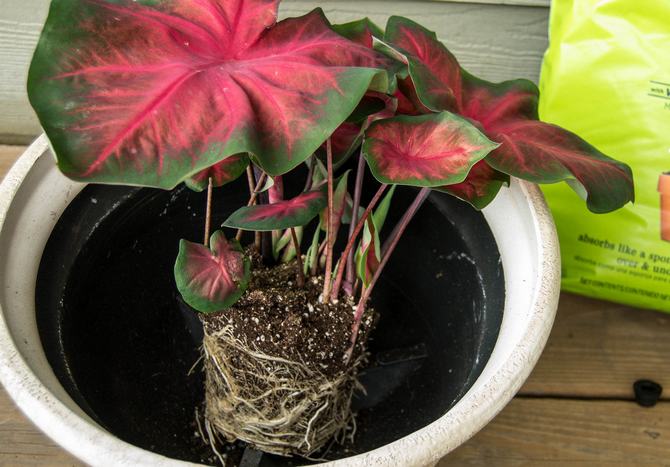

All planting manipulations must be carried out with rubber gloves.because the plant is poisonous.
Disembarkation on the street
In summer, Caladium can also be planted in open ground, but next to a branchy tree to protect the plant from the scorching sun and wind. The soil must be kept moist at all times. As well as at home, on the street top dressing is required. By autumn, the tubers are dug up and harvested.
Planting seeds
Sow the seeds immediately after they are harvested.... The soil for germination is mixed from sand and sod land 1: 4. Seeds are planted 1 cm, powdered with sand on top. From seed to seed should be 10 cm. Glass is placed on top for a greenhouse effect. Ventilate for half an hour by removing the glass. Moisten with spray. The first shoots will be in 20 days.
General characteristics
The first thing that catches the eye of housewives is the appearance of the flowerpot. They carefully examine its leaves, as well as inflorescences.
Leaf shape
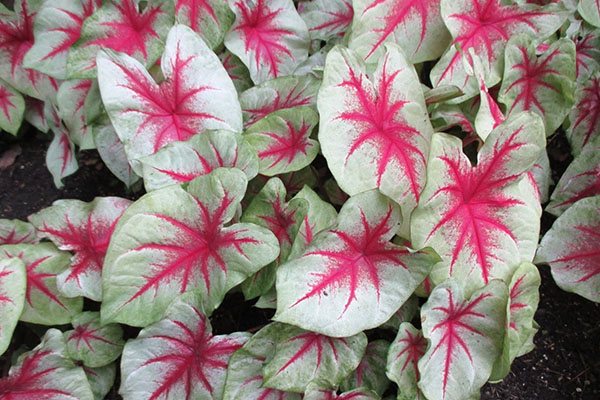

Depending on the variety, this perennial has a different leaf shape. The most famous are:
- In the shape of a heart. Familiar to many under their second name - "Christ's Heart".
- As thin as possible, almost triangular.
- Like an arrowhead or a spear.
- Large and wide, like the ears of an elephant.
They do not have a pronounced stem. Leaves grow directly from the rhizome. In the natural environment, they reach 5 meters, and decorative specimens - only up to 30 cm.
War paint
Appreciate this variety of Aroids for an amazing combination of bright colors. Although there is very little green, it is still dominant. In this case, the leaves are both dark marsh and greenish-white tones. They often depict "compositions" of:
- patterns;
- streak;
- mosaic ornaments;
- grid pattern;
- abstract spots;
- gradation of shades (smooth transition from one to another).
A distinctive feature of some species is a contrasting multicolor border. In rare cases, the edge of the leaves may be slightly wavy. Among other things, Caladium seduces with its extraordinary combination of bright colors, such as:
- purple;
- pink;
- silver;
- crimson;
- yellow.
This is not a complete list of color variations. The only thing is that the leaves never come with a bluish tint.
Inflorescences
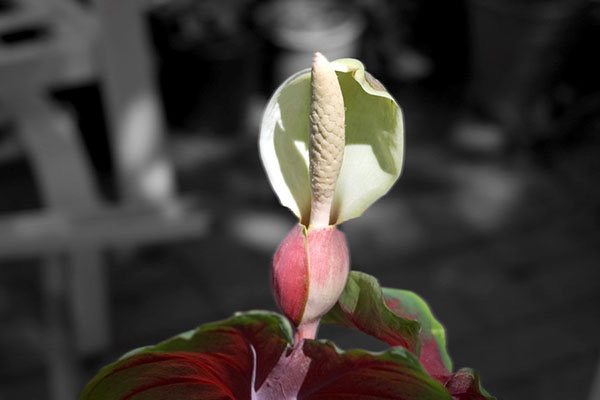

They can be described in two words: miniature and nondescript. Flowering resembles a ball of ashy shade, wrapped in a pale palanquin. It seems as if he is in a cocoon. For exotic lovers, inflorescences will be associated with the wild tropics.
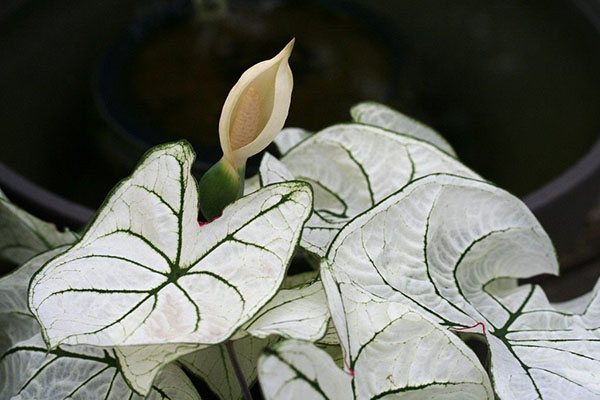

Diseases, pests
Caladium leaves can infect pests such as spider mites, aphids, and mealybugs. To combat them, insecticides are used.
The plant tubers can become infected with bacterial rot. The damaged areas are not difficult to notice when examining the tuber before "hibernation". They must be trimmed and treated with powdered fungicides.
The development of mold on the sheets can provoke waterlogging and draft. First of all, you should cut off the damaged leaves. Then the plant must be removed from the draft and the intensity of watering must be reduced.
Frequent problems
Caladium can show atypical diseases if care rules are violated.
- Leaves are rotting
- falling of water droplets on them. - Caladium wastes away
- low air humidity and drafts. - Leaves fall in autumn
- the plant prepares for the dormant period.
As you can see, handsome Caladium presents
certain requirements for care. However, you can find an approach to it - you just need to be patient and comply with all the necessary conditions. For all the work, the florist will be rewarded with fireworks of bright leaves of the original color.
Caladium is a charming plant with decorative leaves. It belongs to the Aroid family and is distributed in the tropical and subtropical humid forests of Latin America. For the amazing beauty of the leaves, Caladium is called "angel wings", "elephant ears" and "the heart of Jesus." Alas, the period of wakefulness and active growth is only a few months a year. Provided the caladium is comfortably maintained, it forms a sprawling bush with leaves of amazing beauty.
Possible problems when growing Caladium
Very often, when growing caladium, various difficulties arise.
Here are some of the most common and tips for solving them:
- Mold... Perhaps the reason is excess moisture or drafts. It is necessary to change the watering regime and remove the plant from the ventilated place.
- Twisted leaves. The culprit is poor watering or too high temperature. Change watering to more intensive and spray the plant with water.
- The leaves turned brown. The plant is freezing, you need to put it in a warm place.
- The leaves are very pale. Lack of light.
- The plant is deformed... The reason is aphids. Urgently need to be treated with insecticides.
- The tuber is rotting. Rot is formed from frequent watering and low temperatures.
- Leaves dry and turn yellow. In the fall, this is normal, the flower is getting ready for bed. But in the active season, this is evidence of a poor drainage system.
- The edges of the leaves dry out. Excess sun, very frequent feeding, or over-watering.
- The plant hardly grows, the leaves are small... Lack of vitamins, light, poor watering, poor soil. It is necessary to apply complex fertilizers, fix the irrigation system, change the soil.
Caladium varieties
As mentioned above, there are now a huge number of Caladium varieties. Some of the most beautiful and popular in front of you:
- "Candyland" - green leaves with wide creamy pink veins
- "Florida Sweetheart" - pink-purple leaves with a narrow green border around the edges
- "Florida Red Ruffles" - leaves of pink color, smoothly turning into green, the edge of the leaf plate is wavy
- "Fannie Munson" - Raspberry-pink leaves with darker veins
- "Florida Sunrise" - an elongated silvery-green leaf plate decorated with scarlet veins
- "Pink Beauty" - pink-green spots all over the leaf
- "Scarlet Pimpernel" - light gray-green leaves decorated with wide bright pink stripes along the veins
- "Rosalie" - glossy red-brown leaf plates, leaf edge - green
- "Carolyn Whorton" - spotted pattern all over the leaf


Signs and superstitions
"Colors are the smiles of nature," said the popular 19th century writer James Hunt. A person surrounds himself with those colors and colors that help to achieve harmony and peace of mind. Green leaves with a bright red caladium pattern give wings, give self-confidence. Houseplants are a symbol of life, they humidify the air and saturate it with special energy and oxygen.
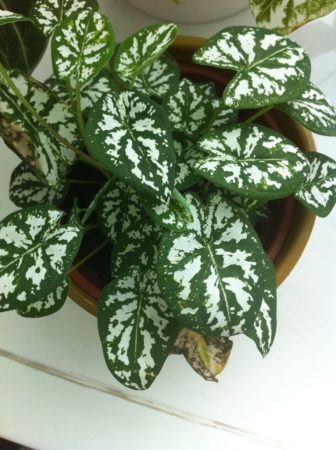

There are no negative superstitions associated with caladium, it is not considered an energy vampire. The only danger is the toxicity of its juice.
Plants, according to the Taoist teachings of Feng Shui, must be placed strictly in the southern parts of the rooms, ideally in the kitchen or living room. In this case, it is necessary to put the pots at a distance from the person.
For lovers of compositions in the form of bonsai, Caladium will not suit unambiguously, since its aesthetic qualities lie in a lush bush. And also biological properties (absence of a stem) will not allow to create such a shape.
3. Varieties:
3.1. Caladium bicolor - Caladium bicolor
Spectacular, evergreen, herbaceous plant from 30 to 80 cm high. Leaves are spear-shaped, on long, thin, glossy petioles. The shades of the leaf plates are very diverse and consist of all sorts of combinations of white, green, red and pink shades. During the flowering period, the plants form a small inflorescence - a cylindrical spike surrounded by a waxy, thick, white or cream blanket.
↑ Up,
Caladium - plant description
Caladiums are often referred to as some of the noblest indoor crops. Not having hard leathery leaves, but remaining thin-leaved and delicate, they are truly unique in their character, and in the choice of varieties, and in the impression they make in the interior. Caladiums are perceived as classic, but vibrant plants, real aristocrats with their own special disposition.
Charming representatives of the Aroid family are endemic to the flora of Latin America. All caladiums are found in humid forests, mainly in tropical, but sometimes subtropical climates. The popular nicknames of Caladiums are a vivid testimony to their beauty. This plant is known as Angel wings, elephant ears, heart of jesus and angel tubers.
Caladiums (Сaladium) - tuberous decorative deciduous herbaceous perennials. Rough, flattened, large, up to 10 cm in diameter, the tubers of the plant seem to be very massive. The adventitious roots are fibrous and small, develop evenly at the bottom of the tuber.
The height of the plant directly depends on the variety and ranges from 20 cm in the most compact varieties to 30-40 cm in most hybrids and almost 70 cm in the largest-leaved specimens. But all the same, caladiums remain compact enough, they never look massive and overwhelming. It is a fast growing, albeit special, plant that looks like a lush, bushy bush of leaves.
In the development of all caladiums there is a pronounced dormant period: the plant sheds its leaves and "hibernates" with one tuber. Caladiums develop somewhat unevenly: it usually takes almost two weeks for them to unfold the first leaf, but then the plants start growing much faster and turn into lush bushes with numerous leaves in a fairly short time.
Modern hybrids often release leaves from the soil throughout the year or have a shifted dormancy period. Traditionally, Caladiums shed their leaves in the fall and stay dry all winter. But plants, like any tuberous, can be driven out at other times.
Bright and large, very beautiful, whole leaves of Caladium are irresistible. Heart-shaped, with a very pointed tip and a very beautiful base, caladium leaves appear translucent and very light. They are not as dense as your favorite large-leaved indoor competitors. Leaves grow on very long and fleshy petioles.
The leaf shape can range from narrower and elongated to more rounded, but the heart-shaped base of the leaves makes it easy to identify the Caladium even from a distance. Leaf sizes range from 10 to 30 cm, while the width is almost always half the length.
Caladiums bloom, and quite effectively, but rarely indoors. <>
The color scheme and flowering of caladiums
The luxurious, small, intricate patterns of caladiums are a trait without which this plant cannot be imagined. On, as a rule, a fairly light base color, contrasting veins appear - white, pink, red patterns. They resemble either marble or complex ornaments.
Caladiums have a limited range of colors, but no one would call it boring. It is believed that it is this plant that has the most original and varied colors among all perennial decorative deciduous stars. White-green or red-green combinations are embodied in different shades and unexpected contrasts. Bright scarlet, raspberry pink, creamy, creamy, silvery white combined with all shades of medium and dark green highlight caladiums against any background.
Despite the status of a purely decorative leafy plant, caladiums bloom, and quite effectively, but rarely in indoor conditions. The peduncle of the plant begins to grow after the full disclosure of the fourth leaf. Caladiums produce ears of a light yellow tone surrounded by a white-light green blanket. The plant fades in a few days; when pollinated, spherical berries of the fruit quickly develop at the place of the cob.
What Caladium Loves
As for proper home care for such a plant, there are a number of important preferences:
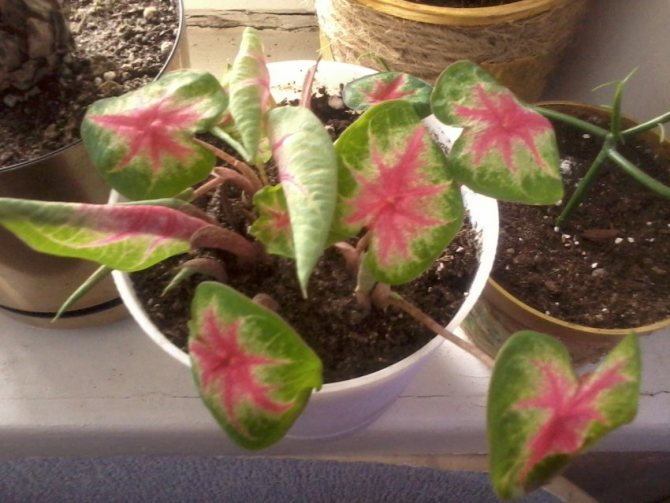

It takes a lot of bright light. BUT! Not direct sunlight - they have a detrimental effect on the flower. It is better to place them on an open balcony or terrace. If you have such a flower in your country house, then you can expose the caladium to the air under a tree to protect it from direct sunlight.
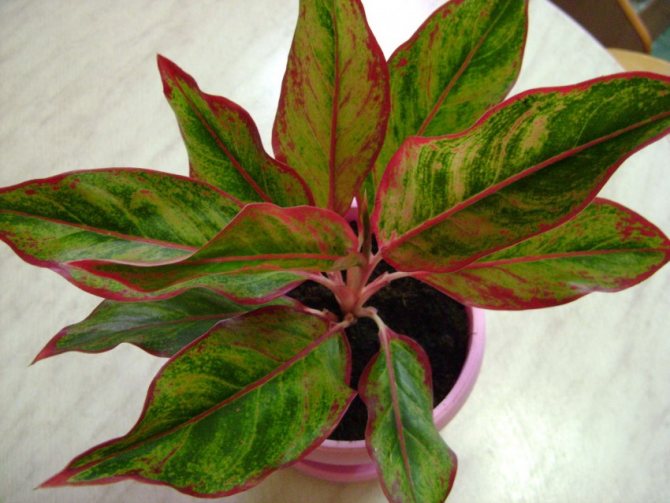

Air humidity is one of the key factors for good growth. It is worth considering this when the air in the house is dry and correct the situation.
We must not forget that the caladium plant has a mandatory period of the so-called "dormancy". Typically autumn-winter. For proper preparation, the amount of watering is reduced already in September. As soon as all the foliage falls, it is a sign that he no longer needs moisture.
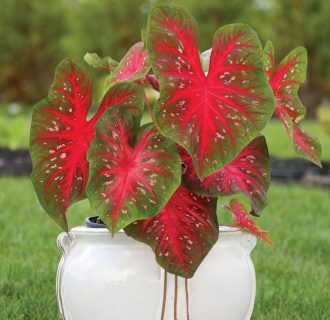

Tubers, once removed, should be carefully peeled and inspected for signs of decay, damage or disease. Places with signs of damage to the tuber tissue are carefully removed, then treated with a fungicide. They need to overwinter in a dry place at room temperature.
Growing conditions for indoor caladiums
Caladiums are not accidentally known as real sissies. They are so demanding on temperatures during the period of active growth, so cold-fearing that it is not always easy to provide them with a comfortable environment, even by lovers of other tropical exotics.
Caladiums pay the price for their extremely stringent temperature requirements with their ability to adapt to milder lighting conditions. But here, too, their unpretentiousness is very relative.
Caladiums must be grown very carefully: the plant is one of the poisonous, the juice can irritate the mucous membranes and skin. Any caladium treatment, including transplantation or hygiene measures, requires hand protection.
Lighting and placement
Caladiums are considered to be plants that adapt well to the place inside the interior. But they cannot be called shade-tolerant, let alone shade-loving. They do not lose patterns on leaves and growth rates only in partial shade or in diffused bright lighting, and in the back of rooms they cannot develop normally.
Of course, it is not necessary to put them on the windowsills, but the lighting should still remain bright enough.When choosing lighting for Caladium, it is worth remembering that the more contrasting patterns and the more flowers appear on the leaves, the more light-loving the plant is.
The delicate, slender leaves of caladiums are hypersensitive to direct sun. They are instantly covered with burns and do not even tolerate midday rays. Lighting for caladiums should be diffused, and special attention should be paid to protection from direct sunlight on hot days. They are comfortable on the western and eastern windowsills, but not on the southern ones.
For caladiums that have entered the dormant stage and are outside or in the soil in a completely dry and warm wintering state, lighting is irrelevant. Pots of tubers can be placed even in a dark room. If the tubers are removed from the soil for a dormant period, they must be protected from light and kept in slightly damp sawdust or peat, paper bags, preventing the tissues from drying out.
Caladiums are ideal candidates for landscaping those areas in which the natural environment is warm and high humidity. Bathroom and kitchen are great options for this culture. But only on condition of protection against temperature surges.
In living rooms, it is better to place caladiums separately: their leaves are much inferior in density to the chosen favorites, and against the background of other decorative deciduous plants, caladiums may look slightly inconspicuous.
Caladiums work best with plants with very small leaves and beautiful flowering, crops that tend to look sloppy and sprawling.
Temperature control and ventilation
Caladiums are one of the most thermophilic plants. Only temperatures above 20 degrees Celsius are considered normal for this culture. Even when dropping leaves and hibernating outside the soil, the tubers should not be kept cool, the permissible minimum air temperature for wintering remains 18-20 degrees. At extremely high temperatures, the tubers dry out quickly and it is difficult for them to find the right storage conditions.
During the period of active growth, it is better to keep caladiums in a stable heat, but without heat. The ideal range for plants to fully reveal their decorative effect is 22-25 degrees Celsius.
Caladiums love stability. They are extremely sensitive not only to temperature extremes, but also to any drafts. The plant should be placed in a secluded, cozy place with an almost unchanging atmosphere.
Caladiums are extremely sensitive not only to temperature extremes, but also to any drafts. <>
Photo of Caladium
Caladium transplant
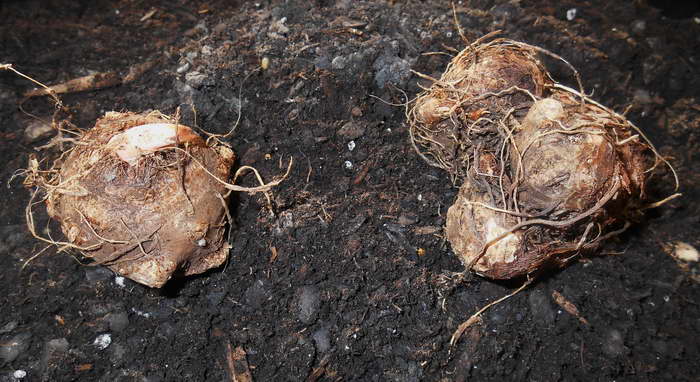

How to plant caladium tubers photo
The transplant is carried out after each rest period (after waking up in February, March).
The soil needs nutritious, water-, air-permeable, neutral or slightly acidic reaction.
The following soils are suitable:
- 1 part of leaf, humus soil, peat and 0.5 part of coarse sand;
- heather land with pine mulch;
- pure peat.
Choose a container for planting according to the size of the root system. For tubers with a diameter of 1-3 cm, a pot with a width of 9-12 cm is required, with a tuber diameter of 4-6 cm - 17-19 cm.
Transplant features:
- Place the tubers with the pink bud facing up.
- Small nodules can be planted in several pieces in one container.
- If you want to get a large number of "babies" by the fall, place the tuber shallow.
- To grow a beautiful, lush bush, bury the tubers to a depth of 5-10 cm.
- After planting, provide minimal watering until new leaves emerge, then water as normal.
Plant species
Caladium Humboldt
Caladium Humboldt
This species became the ancestor of many domestic varieties and is most often used in culture. Arrow-shaped leaves 10 cm long are collected in a rosette. An almost white (silvery) leaf blade with a green edge hides a nondescript bloom. A small flower-cob blooms in April, odorless.
Caladium Schomburg
Caladium Schomburg
The leaf plates have an exotic look. The length of the leaf is 15 cm, it is painted in a silvery-crimson color with dark green veins. The varieties bred on its basis have an unusual beautiful color with a red border and silvery patterns along the veins. This species is native to Brazil.
Caladium bicolor
Caladium bicolor
Caladium bicolor arrived in our greenhouses from the Antilles. Most often, hybrid varieties are grown, since they have more resistant characteristics to diseases and dry air. They are distinguished by a large leaf plate (up to 30 cm), crimson, red, purple in color.
The opinion of breeders
I think Caladium is a very original plant. Wakes up in early spring, falls asleep in mid-autumn, thereby cheering up after winter. I just dig up the tubers for the winter, in the beginning of spring I plant them in pots again. A very beautiful plant that does not require complex winter care.
Svetlana Yurievna
I really love this houseplant. When the bush blooms in the summer, it becomes a real decoration of my small apartment. I have already distributed it among all my acquaintances. It is very simple to propagate Caladium with daughter tubers. They are easily separated and within a couple of years are filled with strength in order to make a beautiful decorative bush.
Irina
Caladium does not have any medicinal properties. Therefore, at home and landscape design, it is used only as an ornamental plant. But in the wild, local tribes extract starch from some species of tubers.
Caladium in natural habitat
In the wild, along the banks of tropical rivers, thickets of coladium form dense undergrowth. The height of these plants can reach five meters, and the leaves are fifty centimeters long and twenty centimeters wide. Its leaf shape is wide, with a sharp point at the end, which is why many call it an elephant ear. The flower is inconspicuous, unisexual, surrounded by a whitish-yellow veil. The fruits are a panicle with berries.
There are about fifteen species of this plant. One of them, Caladium esculentum, has edible roots that are rich in starch. In Brazil, it is grown as an agricultural plant.
Most species only grow in the wild. But those that had decorative leaves were cultivated. And as a result of selection, new varieties of caladium were bred, which are used as garden, greenhouse, indoor plants.
How to care for Caladium when it sleeps
In autumn and winter, Caladium is at rest, i.e. sleeps.
- How to grow and care for an episode at home (50 photos)
- All about ficuses: 30+ varieties with detailed descriptions and photos
- Venus flytrap - benefits in the economy, features of reproduction and home care (50 photos)
Tubers need to be removed from the soil and cleaned from the ground. Places that have damage must be removed, and the sections must be treated with a fungicide. When they are dry, they should be sprinkled with activated carbon powder.
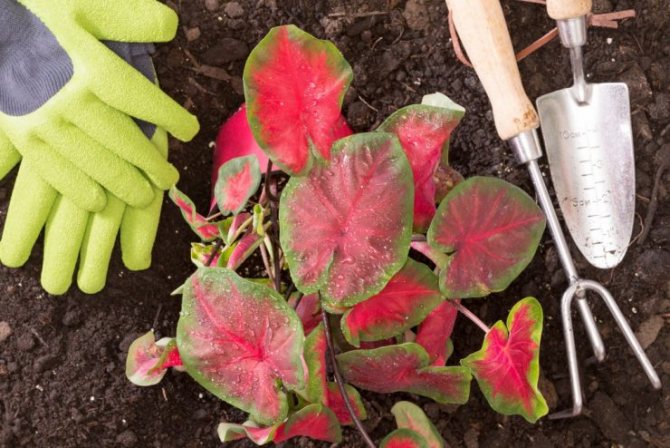

In this state, the tubers are sent for wintering in vermiculite or dry moss. Store them at room temperature.
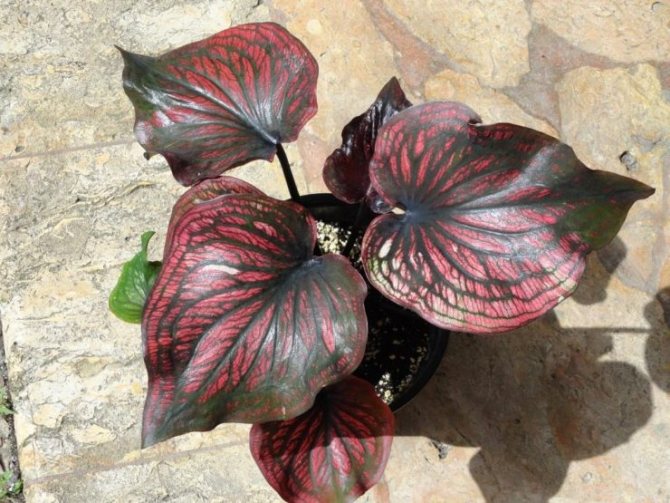

Beginning in late January, the tubers should be checked periodically. When a growth bud appears on its upper part, the tuber should be planted in the soil. The plant will start growing again.
1. Seven Secrets of Success:
| 1. Growing temperature: Can be grown throughout the year at room temperature between 18 and 24 degrees Celsius. During the winter months, it is best to lower the air temperature to 16 degrees Celsius. |
| 2. Lighting: Caladium needs 2-3 hours of direct sun in the morning and evening to maintain the bright color of the leaves, green-leaved plants are successfully grown in partial shade. The flower loves long light days. |
| 3. Watering and humidity: in spring and summer, water so that the topsoil dries slightly between waterings, in autumn and winter, reduce the frequency of watering. It is better to increase the air humidity. |
| 4. Pruning: in the spring, formative pruning is carried out and the tips of young shoots are pinched to form a dense curve of the crown. With sanitary pruning, all old and diseased stems are removed. |
| 5. Priming: Caladium easily tolerates a very wide range of soil conditions and can adapt to almost any substrate that is well drained. However, nutrient-rich soils are preferred. |
| 6. Top dressing: in spring and summer, 2 times a month with mineral and organic fertilizers. During the dormant period, the flower is not fed. |
| 7. Reproduction: separation of tubers during spring transplantation, air layering and stem cuttings, very rarely - sowing seeds in spring. |
Botanical name: Caladium.
Caladium flower - family... Aroid.
Origin... South America.
Description... The genus "Caladium" is very extensive, this plant has tubers, from which heart-shaped, very thin leaves on long petioles appear. In length, the leaf plate can reach 30 - 40 cm. The shades of the leaves are very diverse - in all shades of green, white, red, crimson, pink and purple, with spots and stripes of all kinds of shapes and sizes. Veins can be highlighted in brighter colors. The flowering of this plant is short and is not of particular value, therefore it is recommended to remove the peduncles so that the plant does not waste its strength on flowering.
Height... Caladium can reach a height of 60 cm.
Planting and growing in the garden
Caladium should be planted in open ground when the weather becomes warm enough, that is, in spring. Soil temperature is an important factor as planting too early outdoors can lead to rotting.
Choose a well-drained soil, as caladiums survive in moist conditions. You can understand what kind of soil is in a particular area by observing it after the rain. If there are still puddles of water 5-6 hours after a heavy rain, then do not approach such a site.
Be sure to carefully prepare the soil for planting. It needs to be well loosened and organic substances mixed in a sufficient amount, for example, with:
- rotten manure;
- humus from leaves;
- bone meal.
Use 200-300 g bone meal and 100-150 g fertilizer per m2.
Please note that the landing site is protected from direct sunlight. For caladiums, bright indirect light or partial shadow is best. The leaves of the plant can be damaged by strong winds, so it is best to plant in an area protected from the wind.
Larger bulbs will need to be planted further apart. For the largest, about 30 cm2 can be allocated so that the plant has where to scatter the foliage. Small bulbs can be buried 10-15 cm apart. The bulbs can be cut into segments only in such a way that a bud is present on each of them; however, this will lead to a decrease in leaf production. The more buds, the more stems the flower will have.
Some growers recommend pruning the center bud on the bulb to stimulate leaf growth. Each tuber has a large eye in the center, surrounded by many smaller ones. If you let it grow, the smaller ears won't grow.
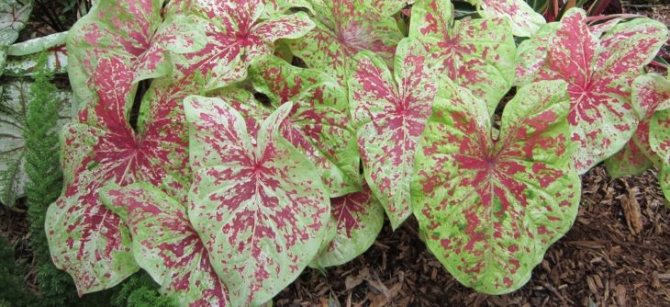

After planting, water generously to help the soil settle around the tubers. Roots and shoots form after a few weeks, depending on the soil and air temperature.
Wintering
In warm frost-free regions, caladiums can remain in the garden, but when grown in northern regions, they will need to be dug up for the winter. This should be done after the first light frost. By this time, almost all of their leaves have already died. Cut them off, and leave the tubers in the fresh air for a couple of weeks to dry (choose a dry place).
Then place them in a mesh bag or box and cover with dry peat moss. Store the plant in a dry place at medium temperatures. Spray the bulbs with water from time to time to keep them hydrated. In the spring, after the danger of frost has passed, transplant Caladium into pots or outside. It will grow again.
An option for the lazy: if you don't want to dig and bury, then just leave the roots in the ground, and plant new ones in the spring.
Possible problems
Putrefaction
Rotting is one of the biggest problems for Caladiums. Rotting is caused by fungus or bacteria and is always preceded by excessive moisture. You can tell the type of rot by its appearance: fungus causes dry rot and bacteria causes slimy. What to do in such cases? The rotten area must be cut out, treated with an appropriate product and sprinkled with charcoal. In the future, do not flood the plant with excessive water.
Burns
Caladiums can be affected by harsh light. If the plants were grown at home or in cloudy weather and are suddenly exposed to bright light, they can get sunburn. Brown spots will appear on the leaves. If this happens, then they need to be put in the shade.
Pests
Caladium is usually not bothered by insects, but sometimes pests such as caterpillars or aphids do appear on them. The best defense against pests is vigilance. If you see torn fields in the foliage, locate the caterpillars and pull them off by hand. If the infection is out of control, use a special tool.
Aphids usually pose no real threat to the flower. They can be washed off with water from a hose, and in advanced cases, use green soap or neem oil.
Care
It is not difficult to keep a flower, if you choose the right place, then you only need to water and fertilize on time for decorative deciduous plants.
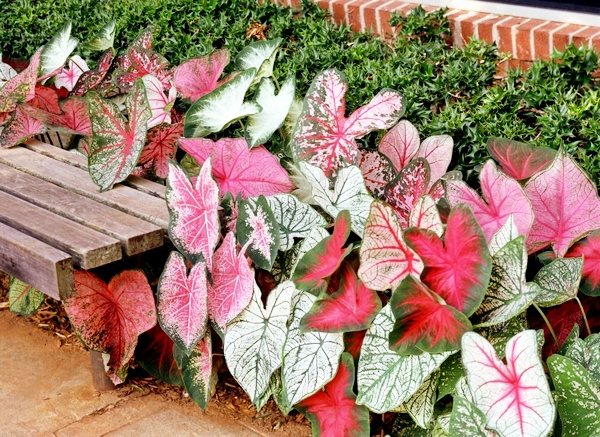

The care scheme is as follows:
- At the end of March, beginning of April, after winter rest, the Caladium is brought out into the light and actively watered.
- Provide optimal temperature - +22 - + 27 ° and humidity, to which it is undemanding, but gratefully responds to a container of water. Constant evaporation provides a favorable atmosphere around the leaves.
- In September, when the leaves dry out, the plant is taken to rest in a dark place until spring. From time to time, the soil is moistened so that the rhizome does not dry out. It takes literally a few tablespoons.
- At the end of winter, the roots are propagated if necessary.
- With the emergence of sprouts, the pot is exposed to the light.
Life cycle, transplant
To properly care for this culture, you need to know its life cycles. Caladium is a seasonal plant that grows actively from the second half of spring to early fall. After that, its leaves begin to dry out and fall off. This means that a period of dormancy begins, and it is necessary to provide the necessary conditions for it. For this, secluded darkened places are well suited. You can, for example, remove the pot under the bed, or place it in a dark closet or closet. However, you should not forget about it, since it needs discreet but regular hydration.
With the onset of spring, the plant must be taken out of a secluded place, the tubers must be removed and examined. They should not have sore spots and other signs of trouble. If diseased or dead areas are found, they must be carefully cut out and the cut sites must be disinfected with charcoal or activated charcoal. Next, a transplant is performed, which should be annual.
The fresh substrate is mixed with a small amount of charcoal, and then the tubers are immersed in it based on their size (immersion is performed to a depth corresponding to their diameter). Abundant moisture is produced and the pot is placed in a darkened place again - the plant likes to wake up gradually. From above, the container is covered with a bag until the first shoots appear from the ground. After that, the shelter is immediately removed, and the pot is transferred to its usual place.
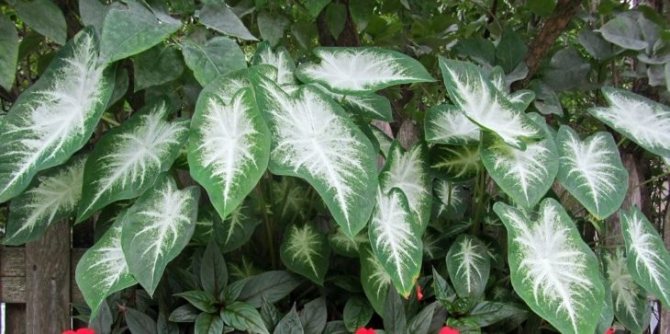

Features of Caladium
Caladium, unlike other plants, does not have a stem. The leaves of this culture grow on straight petioles and form a rosette. The rosettes of an adult plant are usually at least 50 cm in diameter.
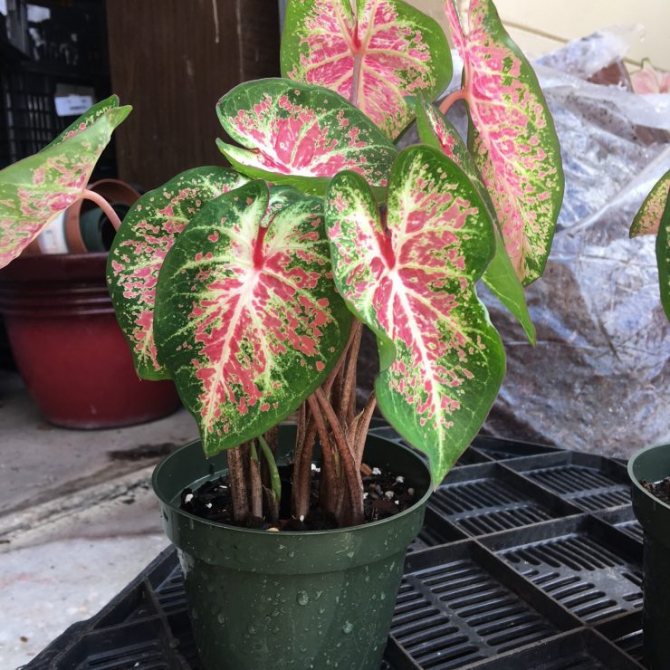

The root system of this culture is a tuber with a rounded-flattened shape of seven to ten centimeters in diameter. At the top of the tuber is the bud of a bush.
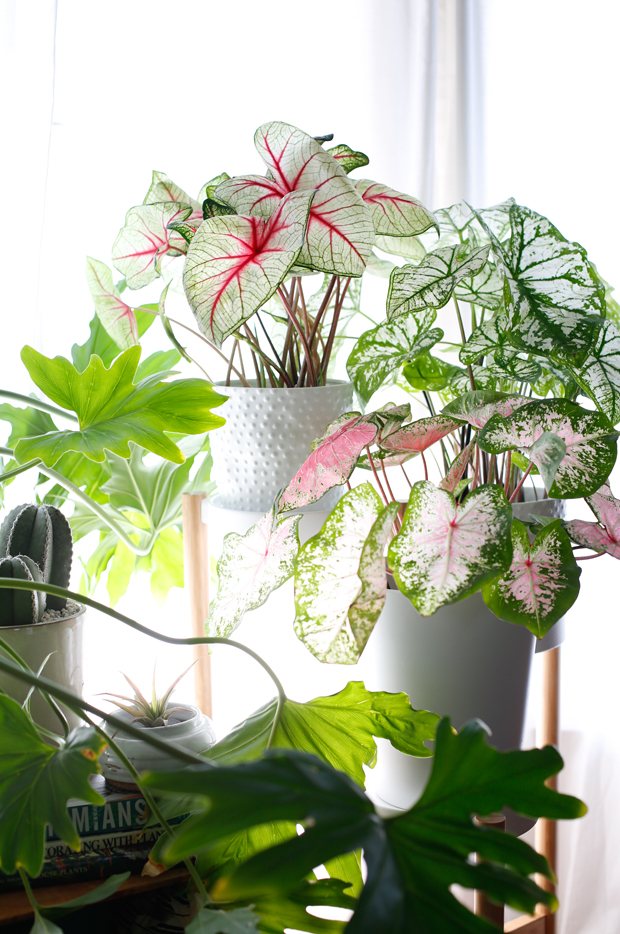

A little further, the kidneys are located at rest. In autumn, the root system of the caladium dies off and the plant hibernates.
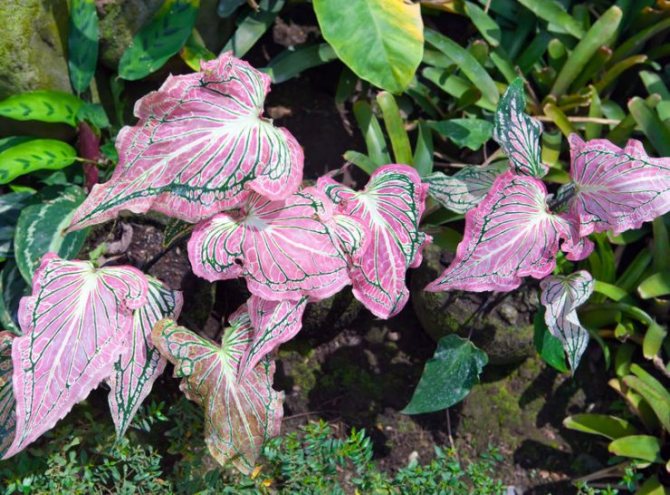

General description with photo
Caladium belongs to the Aroid family. The origin of this plant is from the rainforests that grow along the shores of the Amazon in Brazil. Under natural conditions, it is a very large perennial, reaching 5 meters in height at maturity. In Brazil, the plant is valued for its high starch content, but for our homes it has a decorative value, like other tropical large plants. The plant has very beautiful multi-colored leaves with unique patterns of colored spots, curly veins, edges and unexpected contrasting transitions from one tone to another. The color palette varies in white, beige-silver, fawn, pink-raspberry tones, as well as in all variations of green.
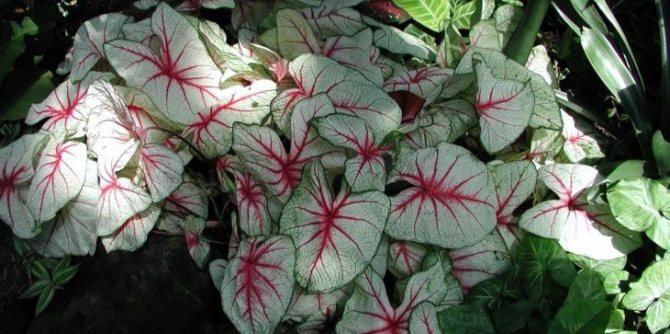

The leaves really resemble elephant ears in shape, heart-shaped, pointed, but they can have different variations in different species - more oval, pointed or elongated. The flowers of this plant, like all members of the family, are inconspicuous and do not represent any particular decorative value. In shape, these are inflorescences in the form of cobs, covered with a pale white-greenish blanket.
Home-grown caladiums are mostly hybrids bred by breeders by crossing different natural species.
Growing caladium from seeds
How to collect seeds
Caladium fruit with seeds photo
Seeds for propagation can be purchased at a flower shop, or you can collect them yourself.
To do this, cross-pollination should be carried out - carefully brush over the flowers of different plants with a soft brush, transferring their pollen to the flowers. The pollinated seeds will ripen after 2 months.
Caladium seeds photo
When the fruit is soft, you will need to crush it and squeeze out the seeds. Then the seeds need to be washed and dried on paper in the shade, stored until spring in a bag made of natural fabric in a cool dry place.
How to sow seeds
- Sow in the spring, in March-April.
- Fill the container with soil consisting of leafy earth and sand (proportions 4 to 1), deepen the seeds by half a centimeter.
- Remember to place a drainage layer at the bottom of the planting container.
- Cover the crops with foil or glass, maintain the air temperature at 25-30 ° C. Air the crops, moisten the soil from a spray gun or through a sump.
- Under favorable conditions, the seeds will sprout in 2-3 weeks.
- Water crops and young seedlings by spraying from a fine spray.
Caladium from seeds at home photo shoots
- For the first time, seedlings are recommended to be sprayed with foundation.
- It is not recommended to dive, so try to plant at once less often, at a distance of 5-7 cm.
- By autumn, full-fledged nodules will form, seedlings for the first time will begin to enter a dormant period. When the leaves begin to die off, you just need to reduce watering and lower the temperature of the content.
- Towards the end of February, check the condition of the tubers: if sprouts begin to appear, carefully plant the tubers in separate cups, provide moderate watering and good lighting. New plants can be fed when well-developed leaves appear.
- Further care is the same as for adult plants.
What can get sick
The most common disease is root rot. The reason is usually an excess of moisture, excessive watering. You need to be very careful during the first month after the transplant. You see that a month has passed, but there are still no leaves, then most likely it is worth talking about the fact that the rhizome is rotting.
What to do? You need to check the root. Dig up and check if the root of a healthy plant is light yellow in color. If it starts to rot, urgently remove the affected areas and treat. Be sure to transplant into new soil.
The plant withers before our eyes, the cause may be a draft.
Mealy worms, mites and even aphids are all pests that can mercilessly attack the caladium plant.
Which exit? It's simple, carry out a thorough treatment with any insecticide.
- Due to the ingress of water droplets, the leaves begin to rot;
- The leaves are curled - the air temperature is too low;
- Waterlogging and drafts contribute to the appearance of mold on the leaves;
- The leaves are less bright and the edges are brown - little light and cold;
- It grows very slowly, the leaves are relatively small - lack of fertilizers.
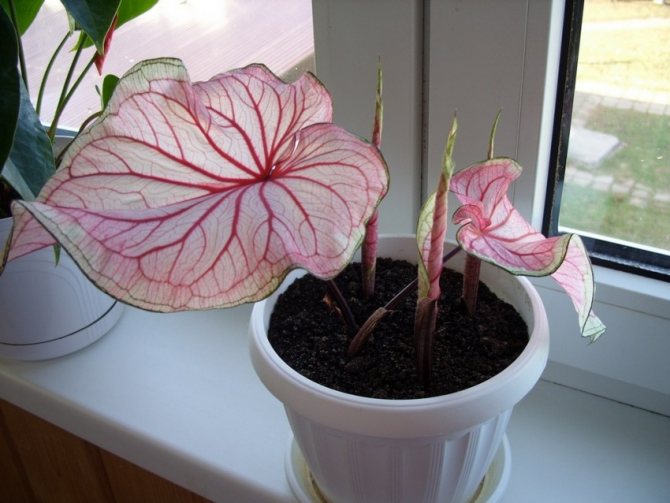

Looking at the colorful photos of Caladium, you understand that in order to admire a gorgeous plant, it is important for it to provide the right conditions for maintenance and development. And believe me, then you will receive such an incredible return of beauty from him.
Conditions for successful growing at home
Having decided to breed caladium at home, plant breeders should be prepared for difficulties. Plants are very demanding to care for. In the absence of optimal microclimatic conditions, Caladium may not leave a state of dormancy for a very long time.
Important! Moisture can be maintained by placing the pots and trays in containers filled with wet gravel. Spraying is categorically contraindicated, otherwise the leaves will lose their attractiveness and may get sunburn.
Lighting
Plants tolerate shade well, but in such cases, their foliage becomes less bright. The ideal location for a Caladium is the northeast and northwest window. Here plants will receive a sufficient amount of diffused sunlight. During the dormant period, the plants do not need lighting at all, so they are transferred to a dark room in which the optimum temperature and humidity are maintained.
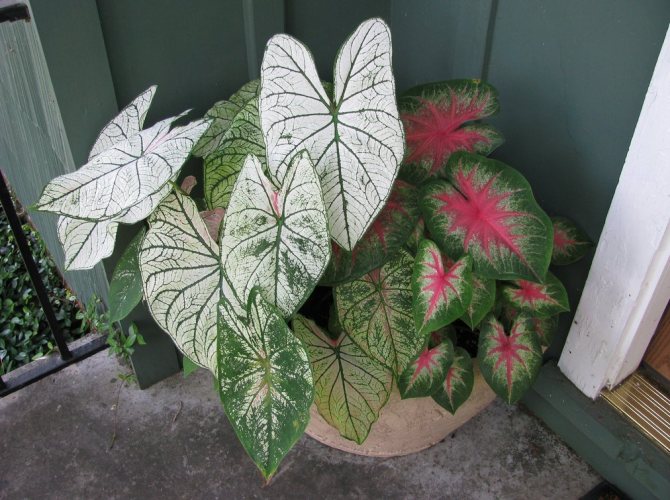

Airing
The supply of a sufficient amount of fresh air into the room at the stage of active development is the key to the successful cultivation of caladium. The main thing is to avoid drafts. You can increase the immunity of plants by exposing them to the balcony for the whole summer or by planting them together with the pots in the garden.
Temperature
For the period of active vegetation, plants should be provided with a temperature regime within + 20 ... + 25 ° C. During the dormant period, plants are less demanding on temperature and thrive at + 16 ° C.
Air humidity
Tropical plants are demanding on moisture. Air humidity should be maintained within 70–80%.
Resting care
As we already said with the onset of autumn, in September, it is necessary to reduce the watering of the plant. And when the leaves begin to dry out, watering should be stopped altogether. The tubers can be left in the pot, but we recommend pulling them out, because by removing the soil and roots, we can detect various damage and rot and prevent the death of the tuber. Damaged areas must be cut off and treated with fungicite, then after drying, sprinkle with activated carbon.If you left it in the ground, then you do not need to water, the pot must be removed to a dark, dry place, then with the onset of the first heat, you should pull out the tuber and transplant it into another container. At first, we water it lightly, and already with the appearance of the first leaves, we carry out full watering.
Landing features
Consider the rules for planting caladium for the case when you need to do this, having a ready-made tuber.
Choosing a pot
The size of the container is important, it should be twice as large as the tuber itself. Often, two or more pieces of rhizome are planted in one pot. The calculation here will be as follows: for two tubers, a container with a diameter of 10 cm is selected, for a larger quantity, 15 cm and more in direct proportion to the amount of planting material per container.
Planting process
The lower drainage layer is obligatory, for which you can choose medium-fraction materials (pebbles, broken brick, etc.). On top of it, sand is poured, preferably coarse river sand. The soil mixture is poured onto the sand in a slide and slightly moistened. After that, a depression is made in the center of the poured slide, into which a little sand is poured, and then the tuber is laid in the same way in order to immerse only a third of it. After that, everything is covered with the remaining soil.
Planting rule: for forcing a large amount of greenery, the root is buried deeper, but if the goal is to obtain more planting material, the tuber is laid more superficially.
Care before root formation
The fundamental factor in this stage of growing caladium at home is good drainage and the right temperature. It should be high enough, around + 24 ... + 29C. It is better to cover the pot with foil or glass so as not to block the light and create tropical greenhouse conditions. Watering is carried out every 2-3 days, simultaneously with the ventilation of the container.
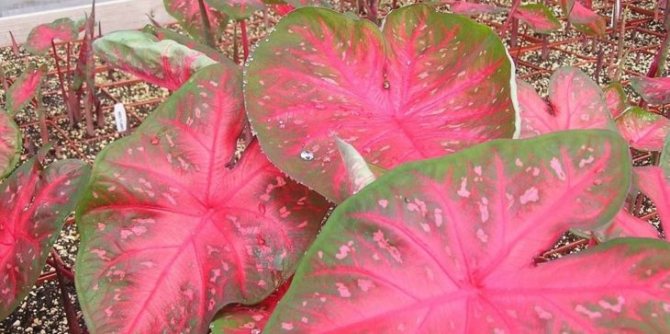

Planting and breeding
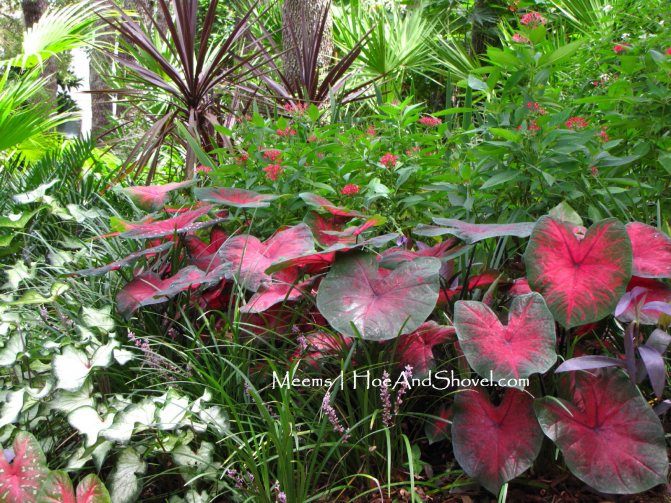

Reproduction
There is a vegetative and generative way of reproduction. It is difficult to get seeds on your own, they will not bear hereditary characteristics and will quickly lose their germination. For germination, soil for aroid plants is sterilized and well moistened. The container with seeds is covered with glass or foil, placed in a warm place + 25 ... + 30 degrees. Small tubers are formed by autumn.
At the end of February, a large tuber can be divided into parts. Each part should have multiple buds. The cut site is treated with charcoal or fungicide, dried. Often, babies form next to the mother tuber. They can be carefully separated and planted as an independent plant.
Reproduction by cuttings is possible in May. A cutting with a leaf is cut at the base and rooted in water. After the appearance of a small tuber, it is rooted in the soil.
Transfer
Every spring, after checking and cleaning the tubers, they are planted in pots with a large drainage layer. You can plant either one large or several small bulbs in one pot. The soil should be nutritious and loose. The composition of the earth includes humus, peat and garden soil in a ratio of 1: 1: 1. It is useful to add sphagnum or coal in small quantities. The finished mixture is pre-sterilized.
Plant root formation stimulants
Stimulants of root formation help not only the rapid rooting of the cuttings, but also, thanks to phytohormones, improve the survival rate of the plant in a new place. The composition of Kornevin, Heteroauxin, Kornerosta includes substances such as indolyl-3-acetic, naphthylacetic and beta-indoleacetic acids. They promote cell division and elongation, forming new roots.
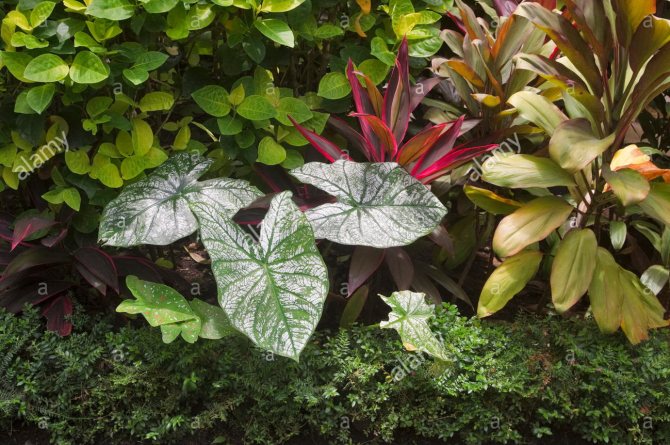

Dormant period
In September, the plant begins to prepare for hibernation. By this time, watering is reduced and fertilization is stopped. The tubers are removed, cleaned from the ground and checked for fungal attack. After processing, it is stored in vermiculite or moss at normal room temperature until the first shoots appear.
Benefit and harm
At the caladium poisonous juice, therefore, it must be kept away from children, and also protected by gloves when caring for it. The inhabitants of the homeland of this plant used its tubers for food, which is why it has such a name - "a plant with an edible root."
Florists should pay attention to such representatives of bushy plants as murraya, palisota, poliscias, arrowroot, nightshade, aucuba, strobilantes, taro and kufeya.

